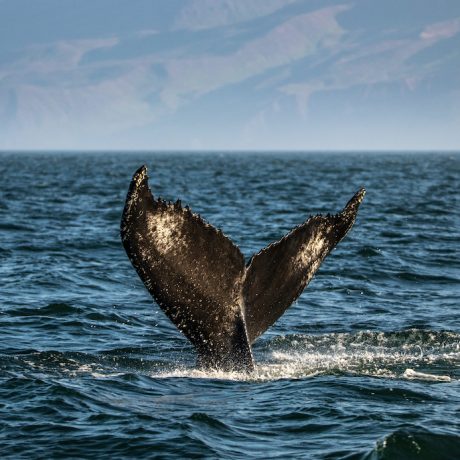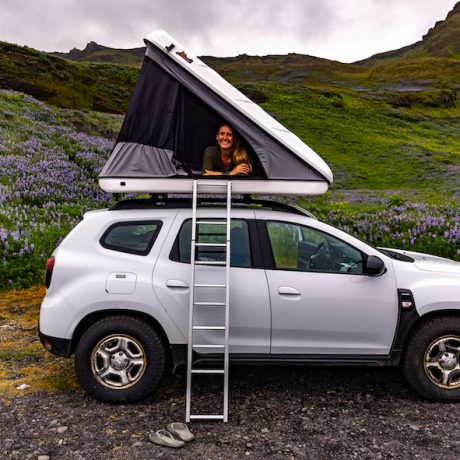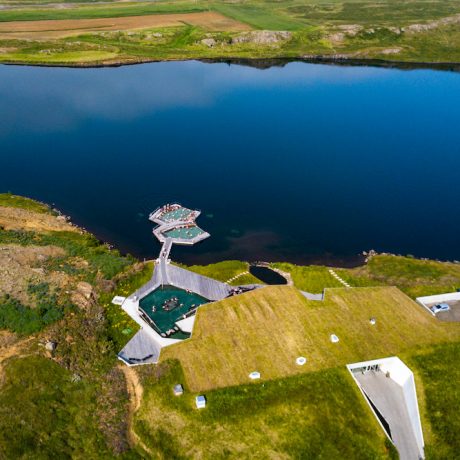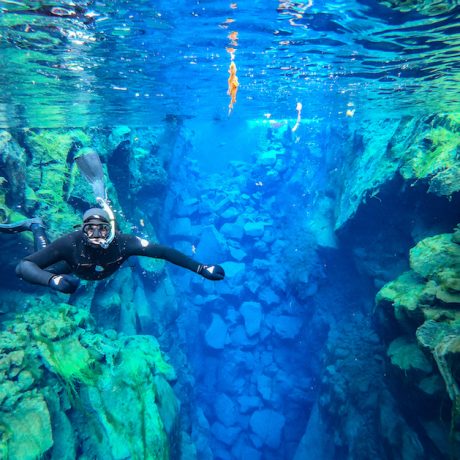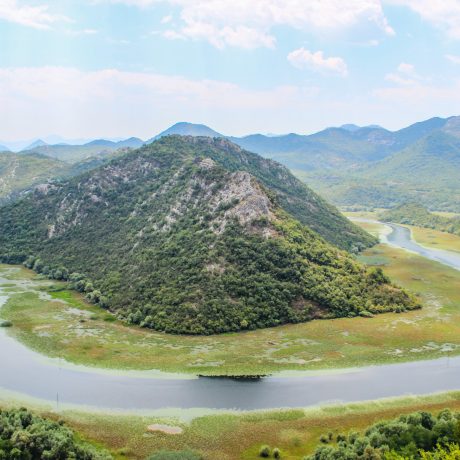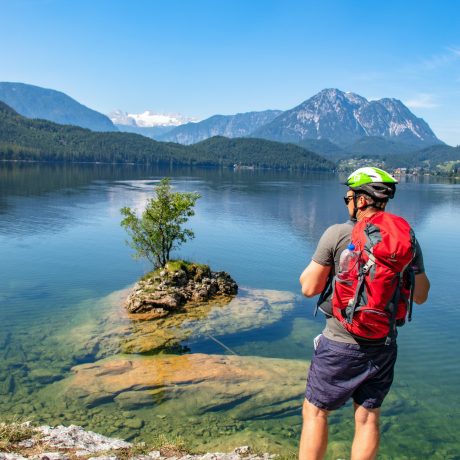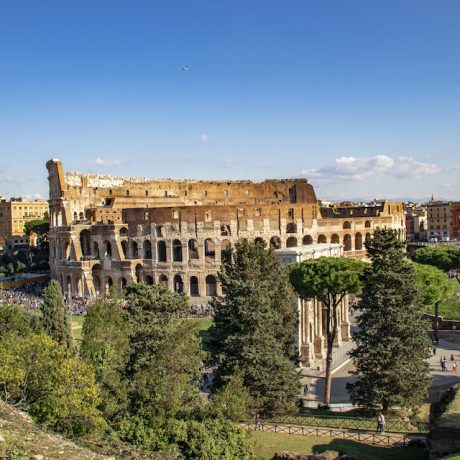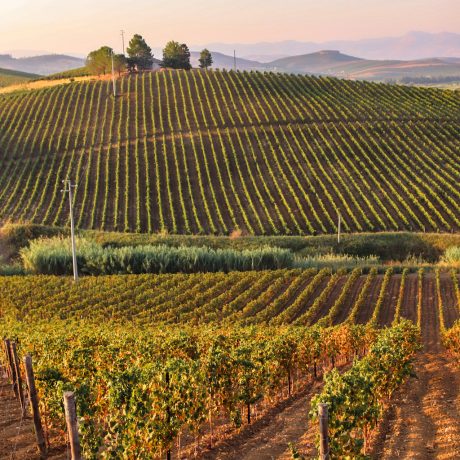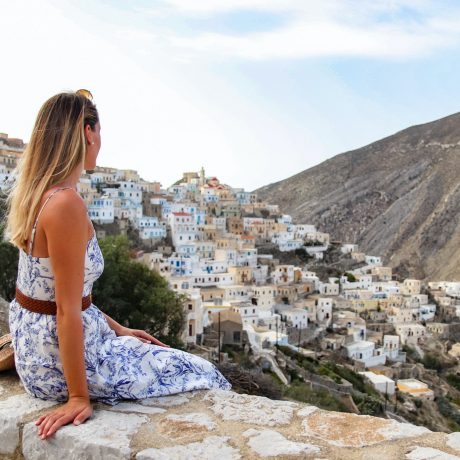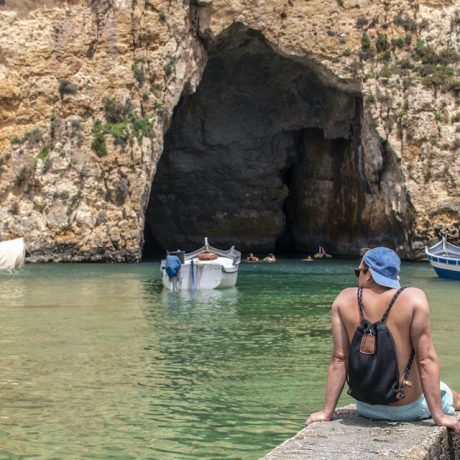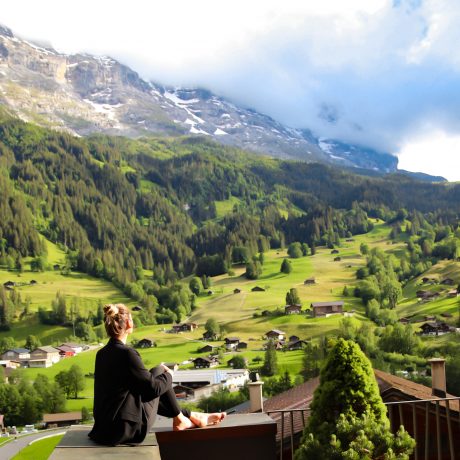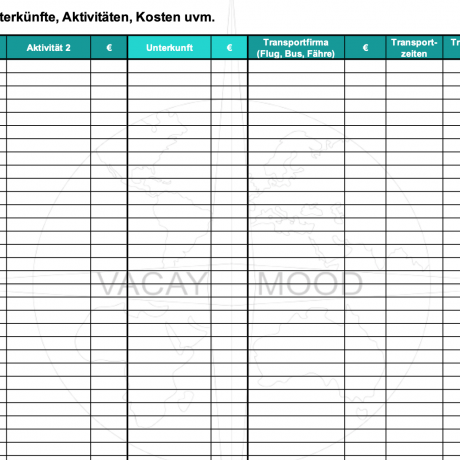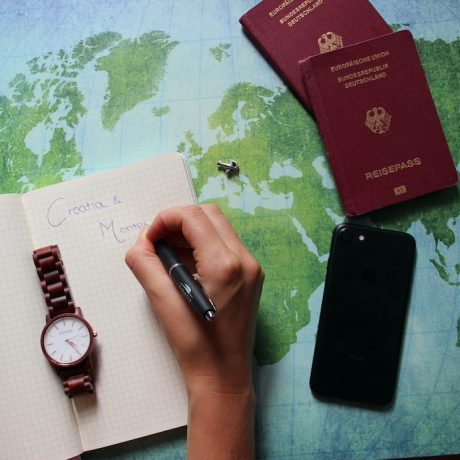*Dieser Artikel enthält unbezahlte Werbung und Affiliate Links
Runter scrollen für VULKAN UPDATE und Live-Webcam: Fagradalsfjall, Geldingadalir, Litli-Hrútur
Anreise nach Island
Die Anreise nach Island wird in den allermeisten Fällen per Flugzeug über den internationalen Flughafen Keflavik stattfinden. Der Flughafen ist wirklich klasse und gut durchdacht. Aktuelle Einreisebestimmung findet ihr auf den einschlägigen Seiten.
Reisezeit
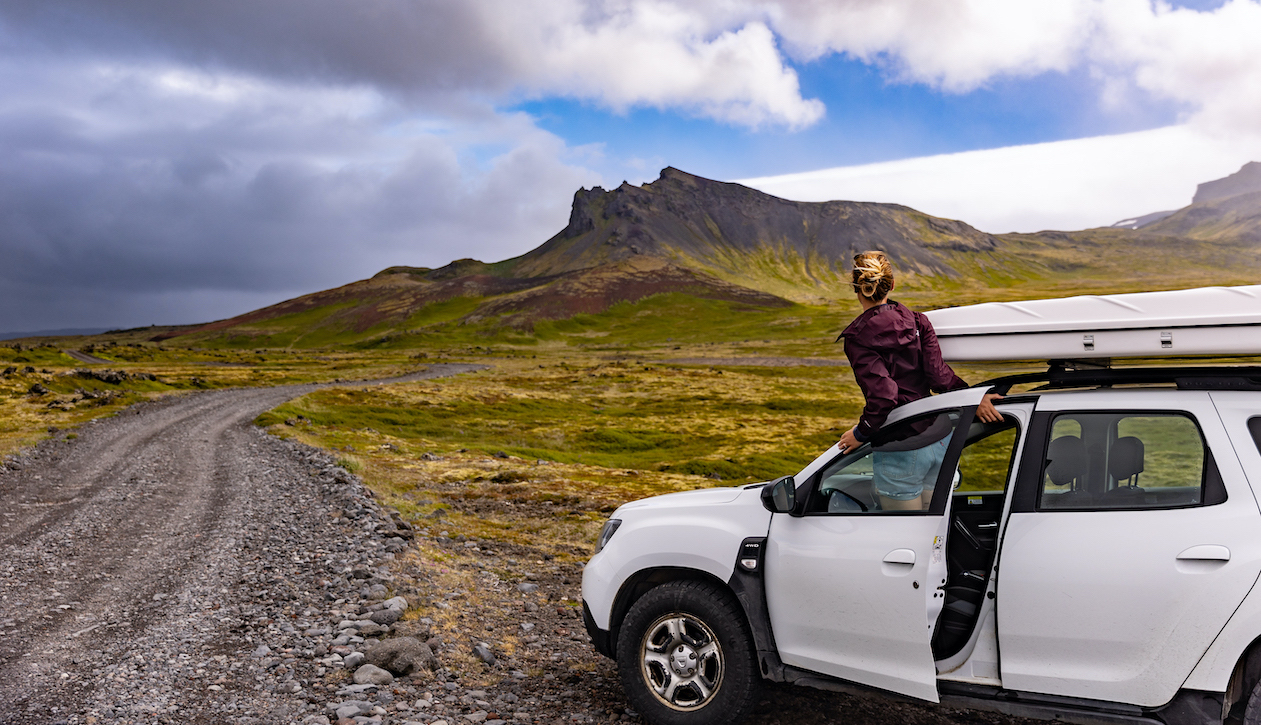
Ein weiterer großer Vorteil der Sommermonate ist natürlich der Faktor Tageslicht. Die Sonne geht im Juni und Juli nur wenige Stunden unter, aber auch in diesen Stunden wird es nicht richtig dunkel, denn die Mitternachtssonne erhellt die Atmosphäre auch aus flachem Winkel ausreichend, um genug Licht zu spenden.
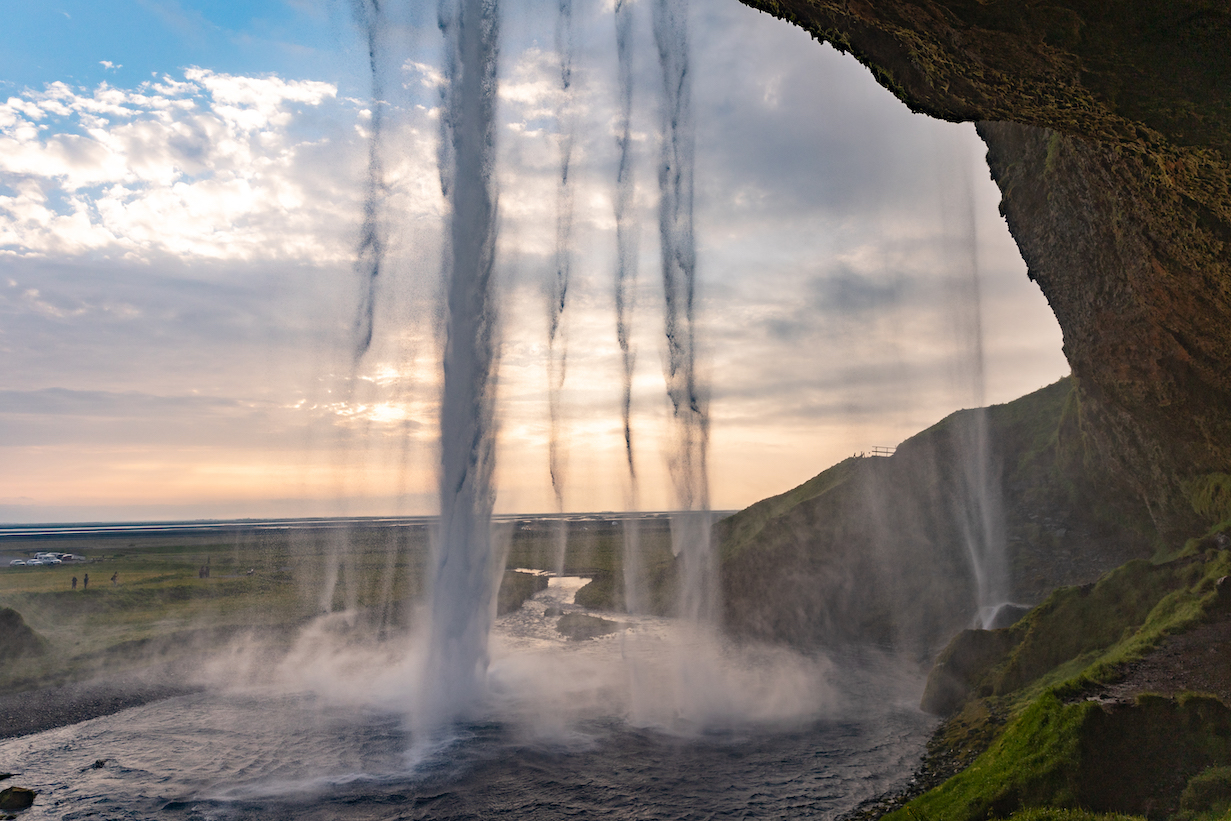
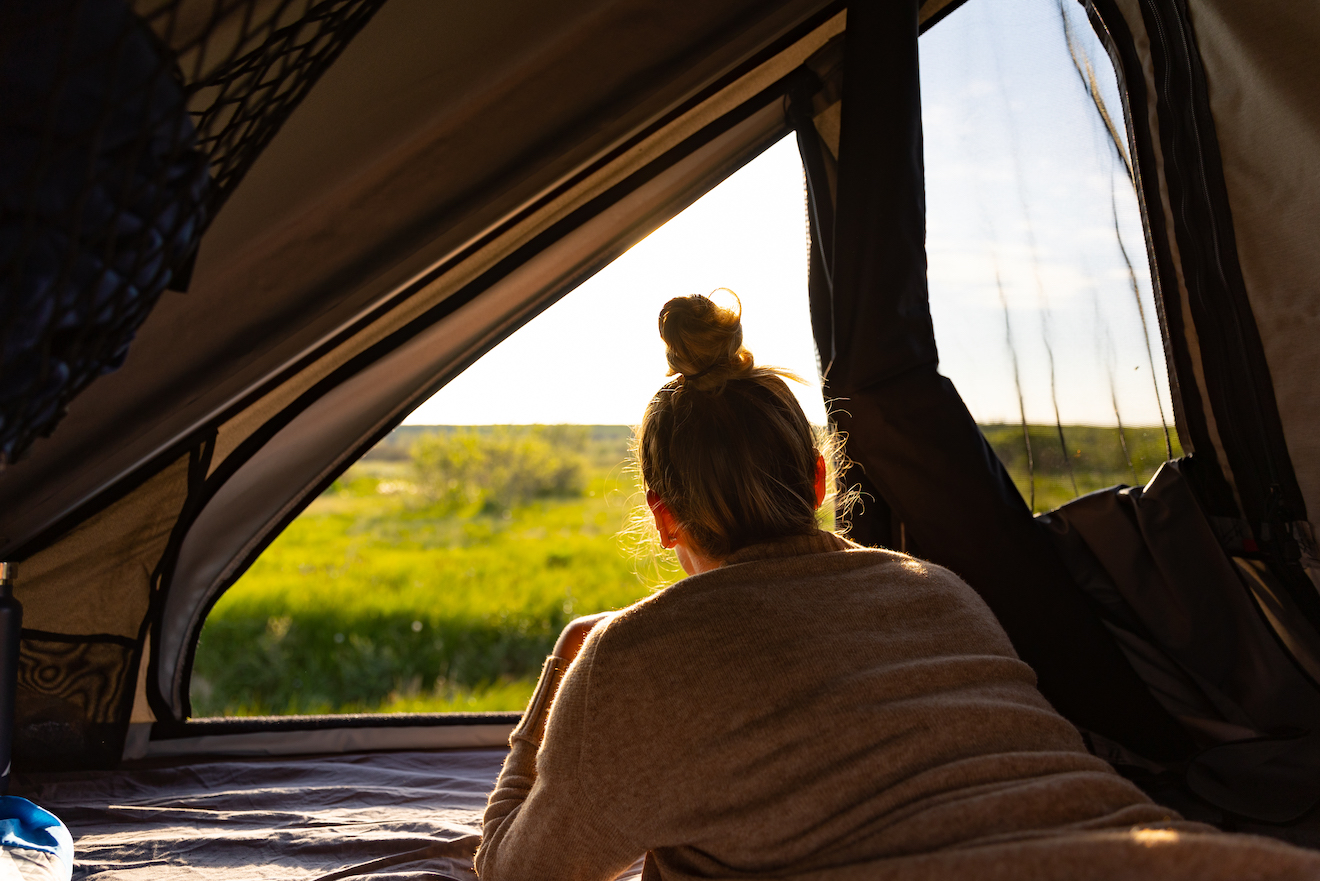
Camper
Buchung, Abholung vom Flughafen und Check-In und Out
Die Recherche zu verschiedenen Modellen von Campern auf der Website von Icerental 4×4 [anzeige] gestaltet sich sehr einfach. Wir haben per Mail Kontakt aufgenommen und wurden super beraten. Netterweise haben wir auch viele Tipps für unsere Route bekommen. Der Buchungsprozess war super und wir konnten sogar kurzfristig eine kleine Datumsanpassung vornehmen. Icerental 4×4 liegt wirklich viel daran, den Kunden eine gute Zeit auf Island zu bereiten. Noch von zuhause aus haben wir einen Online Check-in durchgeführt, sodass das administrative Prozedere vor Ort auf das Nötigste reduziert wird.
Aber der Reihe nach: Wir wurden am Flughafen pünktlich abgehholt. Unser Flug landete um 01:00 Uhr nachts. Trotzdem wurden wir in der Eingangshalle des Flughafens bereits erwartet und in Empfang genommen. Icerental 4×4 operiert rund um die Uhr. Mit einem Kleinbus wurden wir in etwa zehn Minuten zum Büro der Vermietung gefahren, wo wir nach dem Papierkram eine Einweisung ins Fahrzeug bekamen und schon gleich in unsere Island Rundreise aufbrechen konnten. Alles verlief professionell und hilfsbereit. Auch am Ende unserer Reise lief alles gut. Kurzer Check des Mietwagens und schon wurden wir verabschiedet und an den Flughafen gefahren.
Schlafen/Übernachten im Dachzelt in Island
Wir hatten vor unserer Island Rundreise keinerlei Erfahrung mit einem Dachzelt, sind aber im Nachhinein schwer begeistert von dieser Art zu reisen. Das Dachzelt ist auf einer stabilen Dachreeling montiert und ist im eingefahrenen Zustand etwa 30 Zentimeter hoch. Aufgestellt misst das Dachzelt etwa 1,30 Meter an der höchsten Stelle.
Es ist 1,40 Meter breit und gute 2 Meter lang, sodass auch ein großer Mensch gut darin schlafen kann. Es gibt einige Seitentaschen und eine große Tasche an der Decke des Zelts, wo ihr einiges verstauen könnt. Die Matratze ist ausreichend dick und auch schwerere Personen schlafen gut darauf. Auch dabei sind zwei Kissen und ein Matratzenbezug. Ihr könnt Schlafsäcke von zuhause mitbringen oder bei Icerental 4×4 dazu buchen. Eure Schlafkleidung, Schlafsäcke und andere weiche Gegenstände könnt ihr im zugeklapptem Dachzelt lagern.
Der Aufbau des Dachzelts geht wirklich sehr schnell. Länger als zehn Sekunden dauert das nicht. Im hinteren Bereich des Dachzelt gibt es zwei Klammern, die gelöst werden müssen. Anschließend klappt das Zelt von alleine aus und ihr müsst die Leiter in die dafür vorgesehene Halterung einhängen. Zuletzt müssen die Gelenkstangen am hinteren Zeltende arretiert werden.
Der Abbau des Dachzelts dauert nicht viel länger. Arretierung lösen, Leiter abbauen, Zelt mit dem dafür vorgesehenen Seil runterziehen und den geschlossenen Deckel mit den beiden Klammern verschließen.
Wir haben sehr gut im Dachzelt geschlafen. Zwei Nächte waren etwas kühler, sodass wir uns eine zweite Schicht Kleidung angezogen haben. Das war total ausreichend und sehr komfortabel.
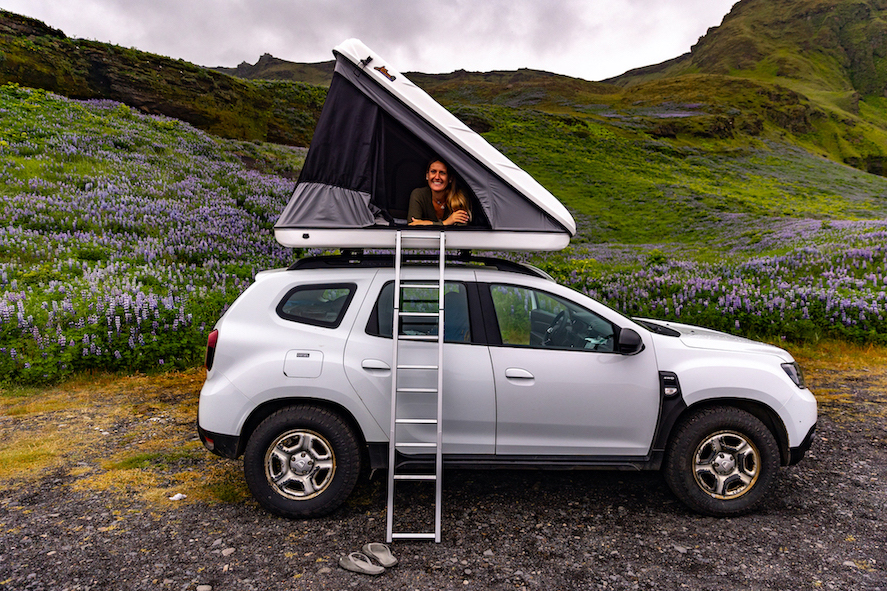
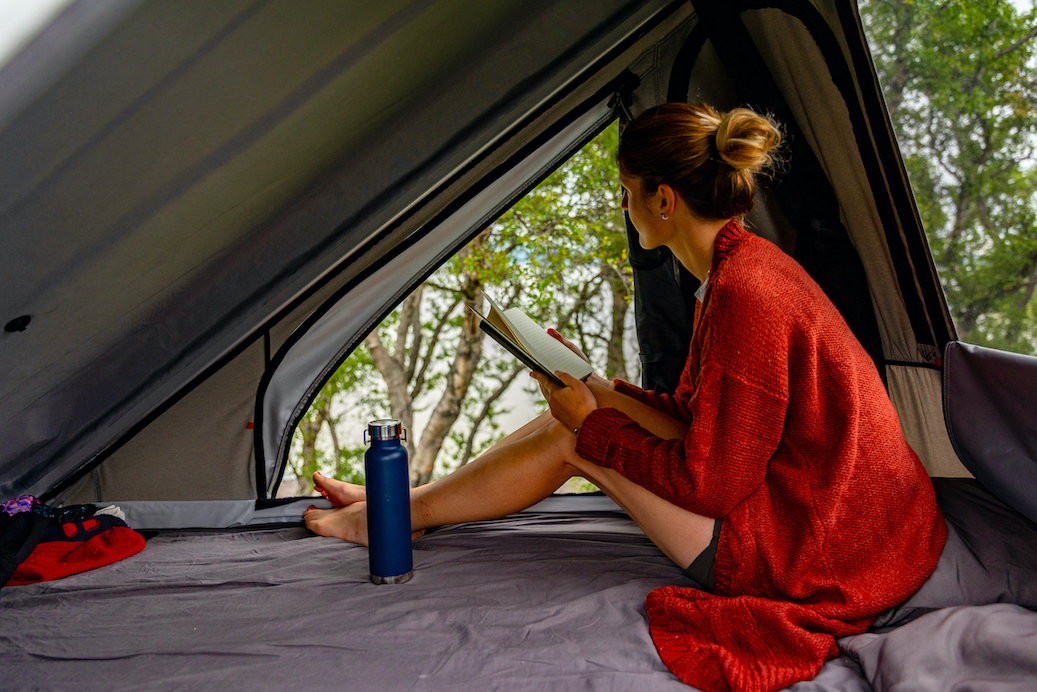
Mietwagen Island
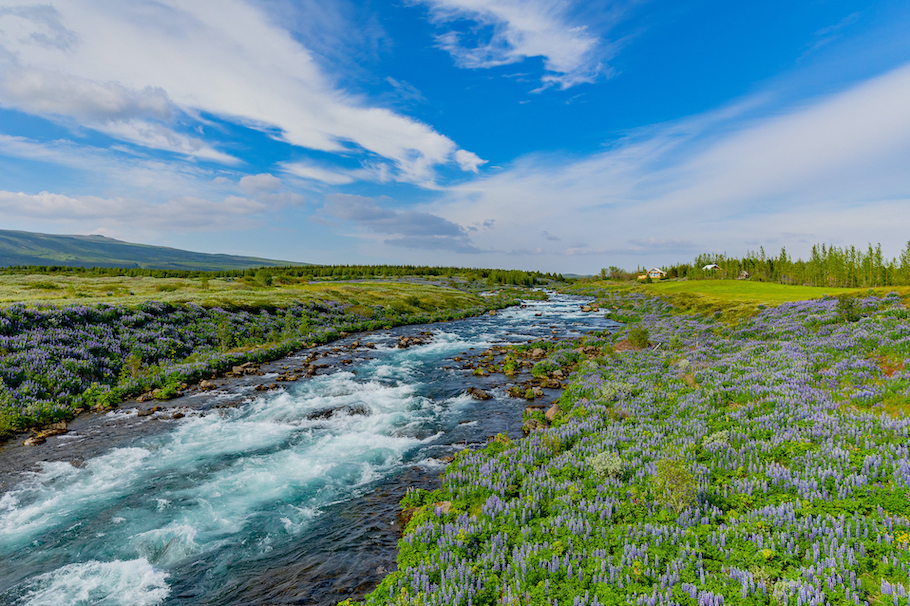
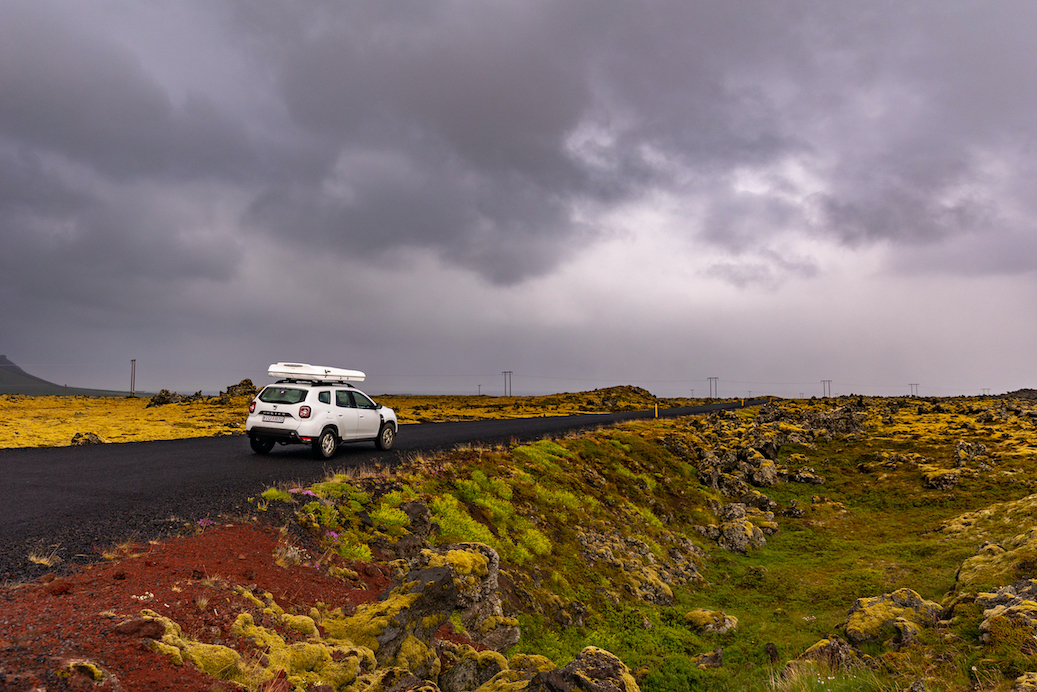
Campingplätze in Island
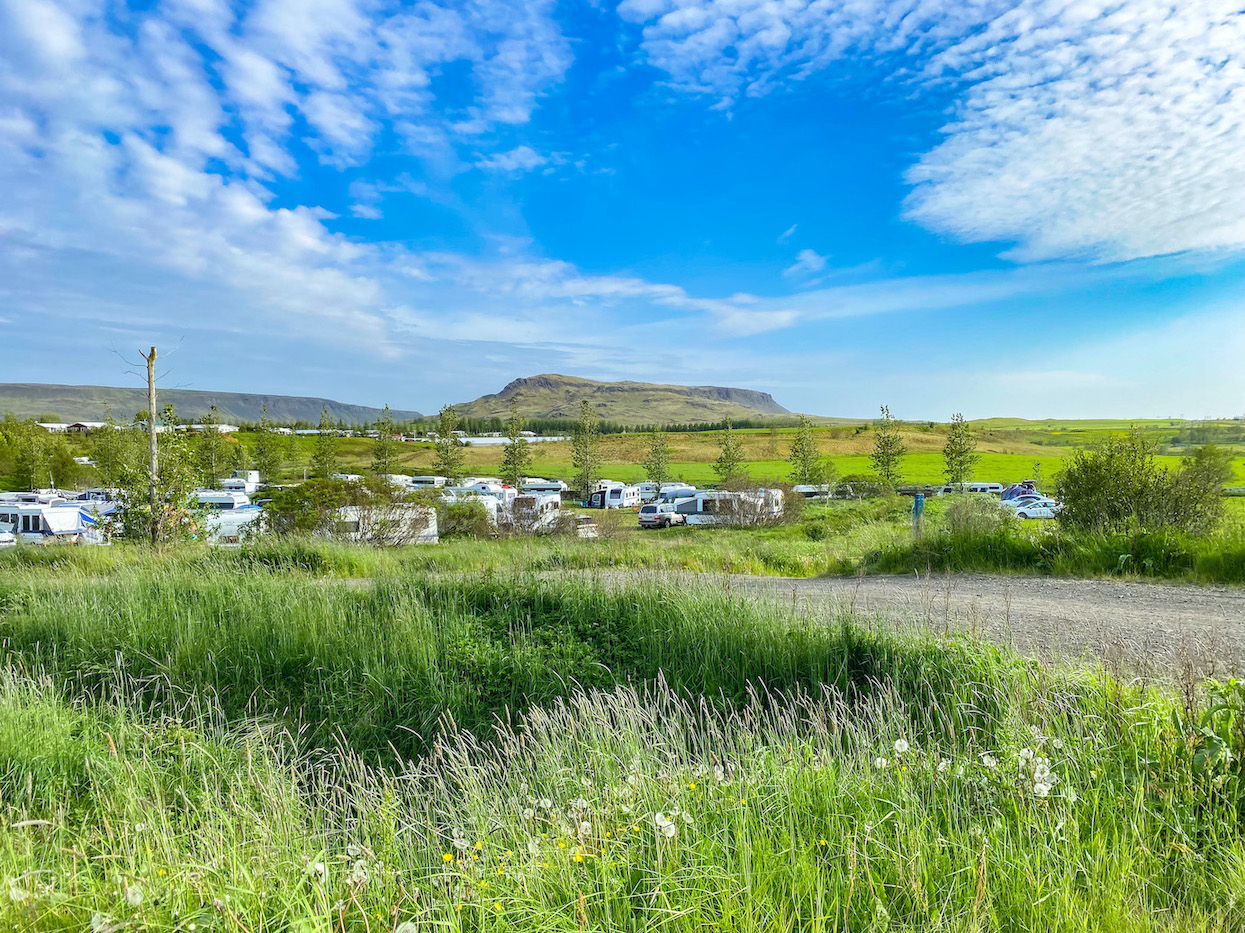
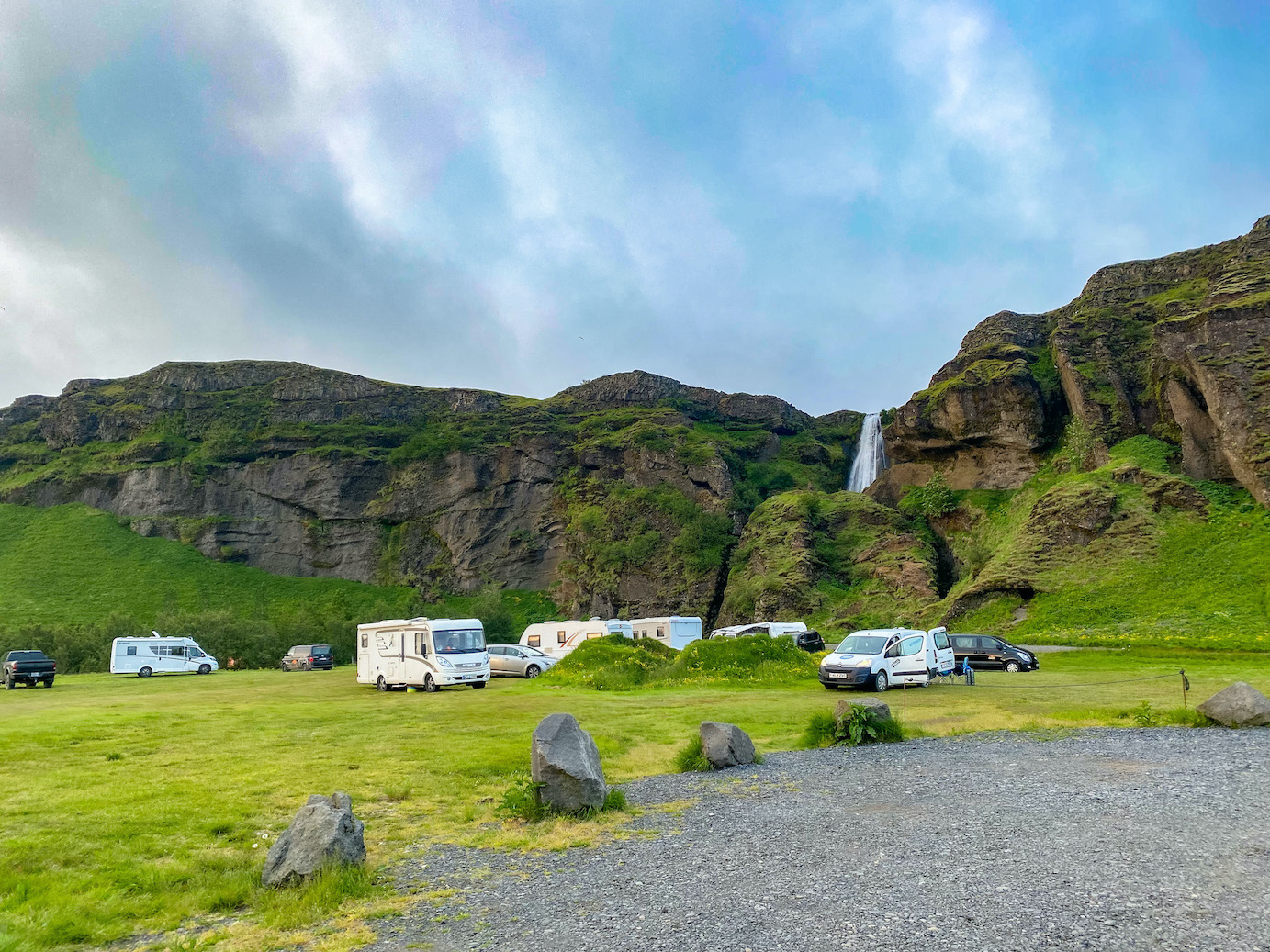
Einkaufen, Kochen und Essen während dem Camping in Island
Entgegen unserer Leidenschaft haben wir es kulinarisch in Island eher Basic gehalten. Wir haben zu unserem Camper mit Dachzelt eine Küchenbox dazu gebucht. Dabei handelt es sich um eine kleine Plastikkiste mit einer Grundausstattung an Geschirr und Besteck, Töpfen und Gaskocher inklusive Kartusche. Damit kann man einfache Dinge wie Nudeln mit Sauce, Eier oder Baked Beans zubereiten.
Wie oben erwähnt, gibt es an manchen Campingplätzen eine Küche, sodass ihr auch mal größer aufkochen und Gas sparen könnt. Wir haben jeden Tag gefrühstückt. Meistens hatten wir Toast, Müsli oder Eier. Für untertags haben wir uns dann Sandwiches vorbereitet. Abends gab es dann entweder eine Kleinigkeit vom Gaskocher oder wir sind in ein kleines Diner oder zu einem Foodtruck auf eine Portion Fish & Chips oder Burger. Hier können wir Fish & Chips vom Hekla Street Food Truck, sowie das Hafnarbudin Diner in Höfn empfehlen.
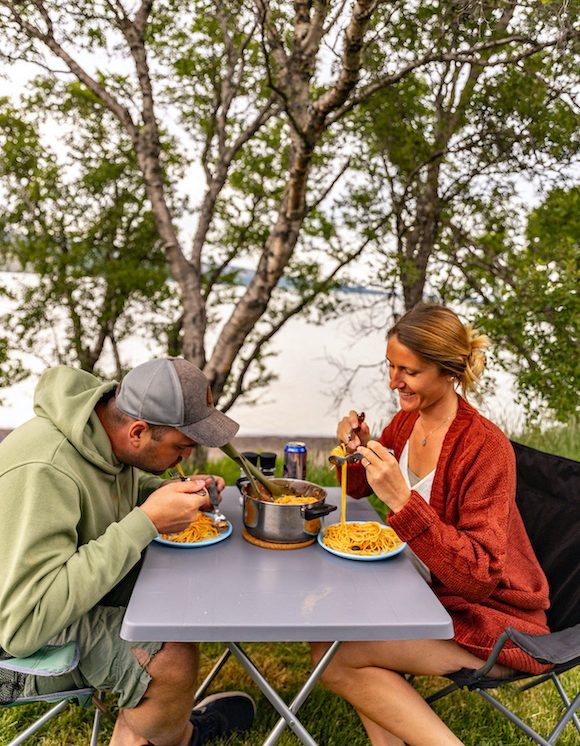
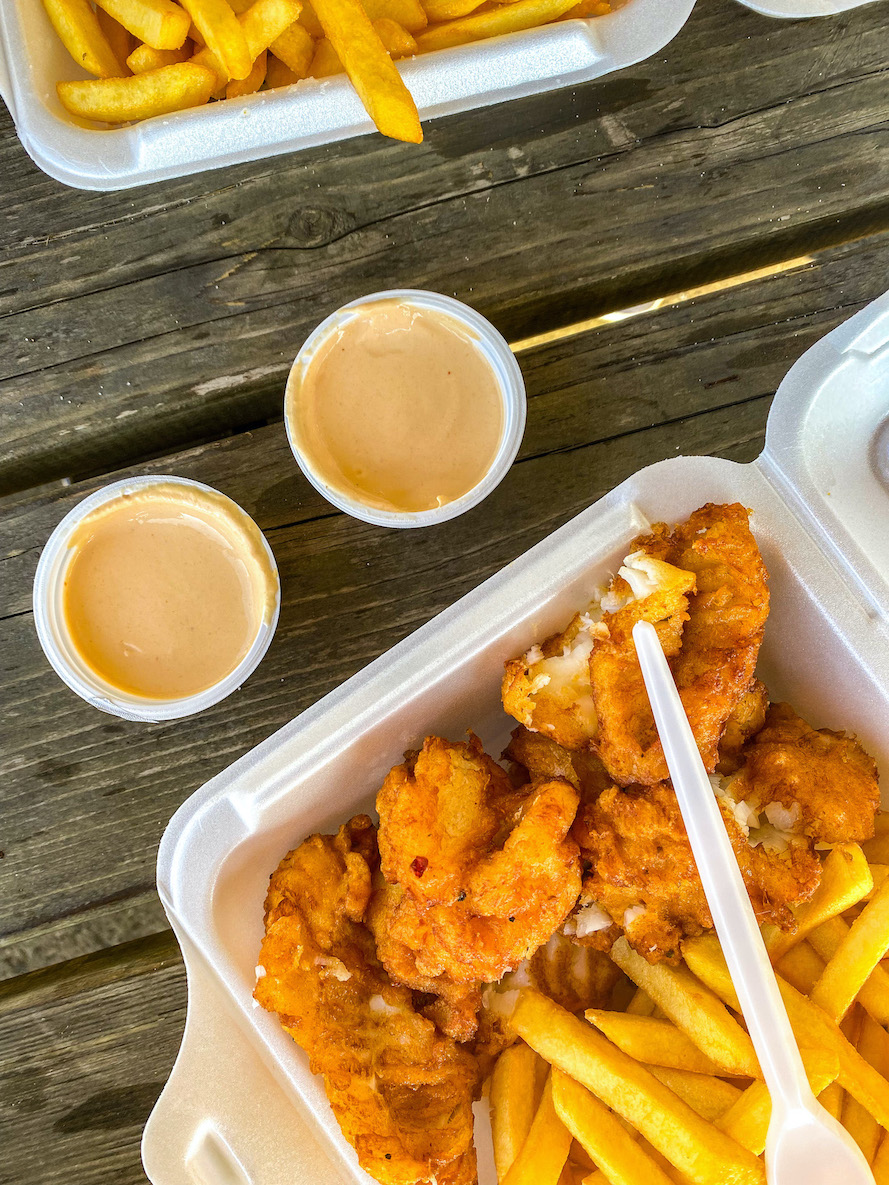
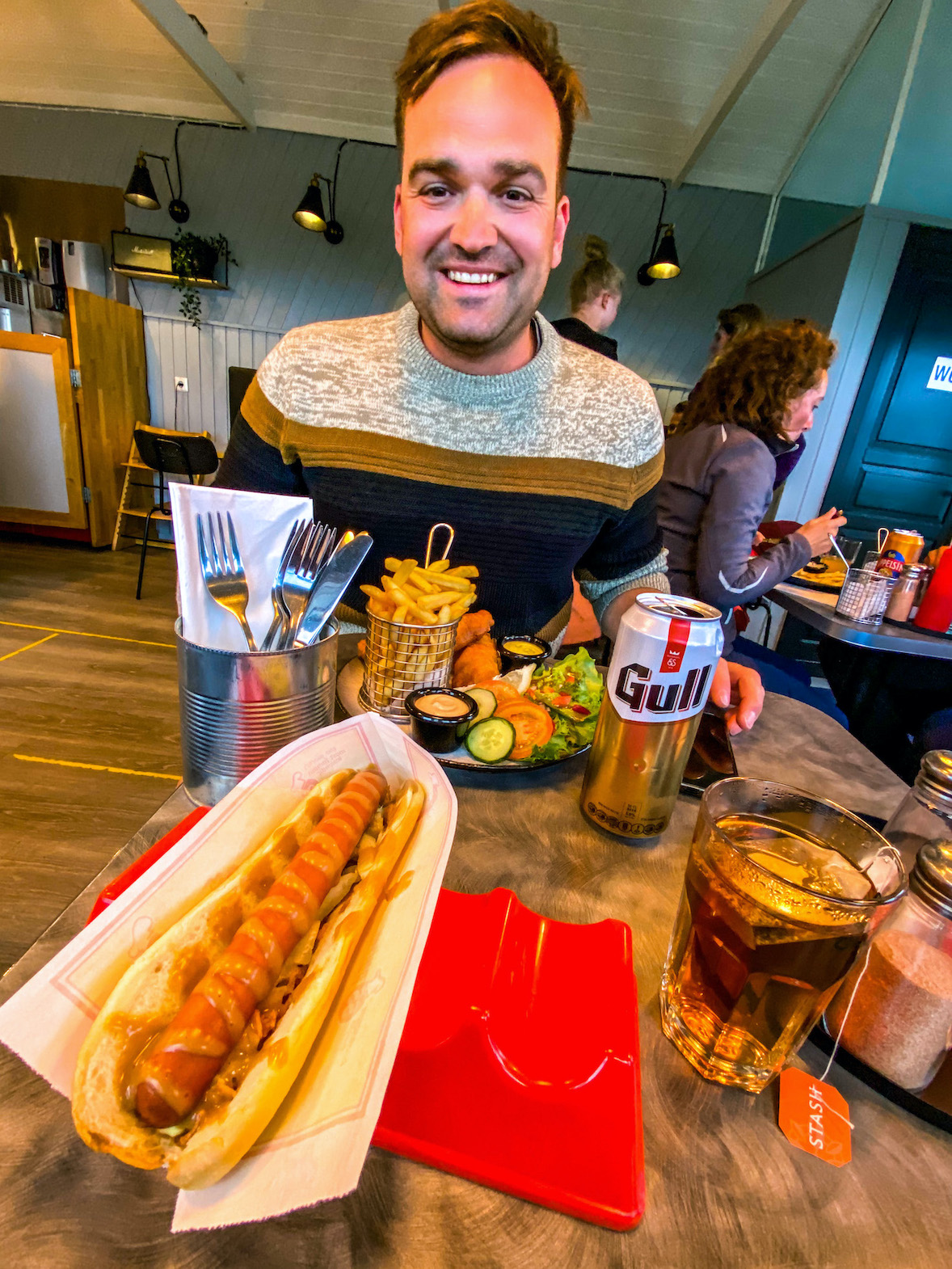
Für den Fall, dass ihr selber kochen wollt, sagen wir euch auch kurz unseren Eindruck zum Einkauf von Lebensmitteln. Wir haben in drei unterschiedlichen Supermärkten eingekauft. Das waren Netto, Kronan und Bonus. Alle drei sind vom Preisniveau her etwas über Deutschem Standard, aber noch vollkommen im Rahmen. Hin und wieder hört man ja, dass man als Deutscher bei einer Reise nach Island oder Skandinavien komplett bankrott zurückkommt. Deutlich teurer sind die an Tankstellen angeschlossenen Supermärkte. Plant also gut im Vorraus und denkt daran, dass ihr unter Umständen keine Möglichkeit zum Kühlen habt – natürlich in Abhängigkeit von eurem gebuchten Camper.
In Sachen Alkohol ist auch einiges zu beachten, denn Bier bekommt ihr zwar in jedem Supermarkt, aber eben nur das Leichtbier mit 2 bis 3% Vol. zu einem Preis in etwa wie in Deutschland. Richtiges Bier bekommt ihr in den staatlichen Alkoholshops namens Vínbúðin. Billiger kommt ihr aber hin, wenn ihr gleich bei Ankunft am Flughafen im Duty Free einkauft. Beachtet aber die erlaubten Einfuhrmengen.
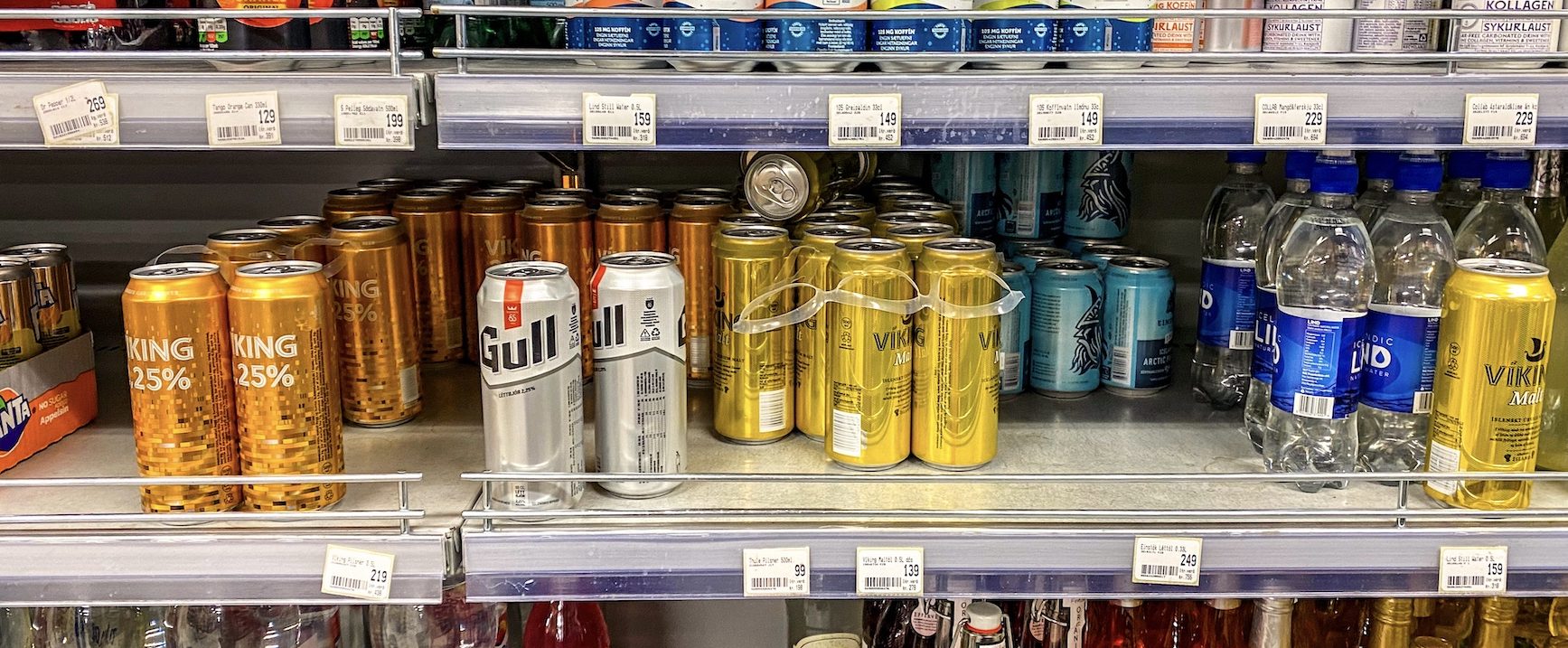
SIM-Karte und WLAN-Abdeckung
ATMS, Geld und Trinkgeld
Kreditkarte ist das üblichste Zahlungsmittel in Island. Mit Bargeld kommt Ihr aber fast überall ans Ziel. Einzig der ein oder andere Parkautomat nimmt kein Cash. An Campingplätzen ist Bargeld gerne gesehen. An machen Plätzen müsst ihr das Duschen mit Münzen extra bezahlen. Für Toiletten an den Parkplätzen der großen Sehenswürdigkeiten schaden ein paar Münzen auch nicht. Wir haben am ATM am Flughafen in Keflavik Bargeld abgehoben, hätten aber davon nicht viel gebraucht. Trinkgeld wird in Island nicht erwartet. Natürlich sträubt sich auch kein Kellner oder Tourguide dagegen, wenn ihr zufrieden seid.
Routenvorschlag für 10 Tage Island mit Highlights
Whale Watching in Husavik
Ein unvergessliches Highlight auf unserer Route durch Island waren die Wale, die wir zusammen mit Husavik Adventures [anzeige] in der Bucht von Husavik gesehen haben. Schon so lange wollten wir die großen Meeressäuger mal aus der Nähe sehen, aber immer konnten wir nur aus der Ferne einen Planscher, Blas oder eine Fluke erahnen. Sobald unser Boot sich aber näherte, war nichts mehr vom Wal zu sehen. Hier in Husavik sollte sich unser Traum endlich erfüllen.
Wir haben online eine Big Whales and Puffins Tour* gebucht. Puffins (Papageitaucher) sind zwischen Mai und August zu sehen. In den anderen Monaten dreht sich die Tour von Husavik Adventures nur um die Wale. In den Monaten Juni und Juli wird auch eine Midnight Sun Whale Watching Tour angeboten.
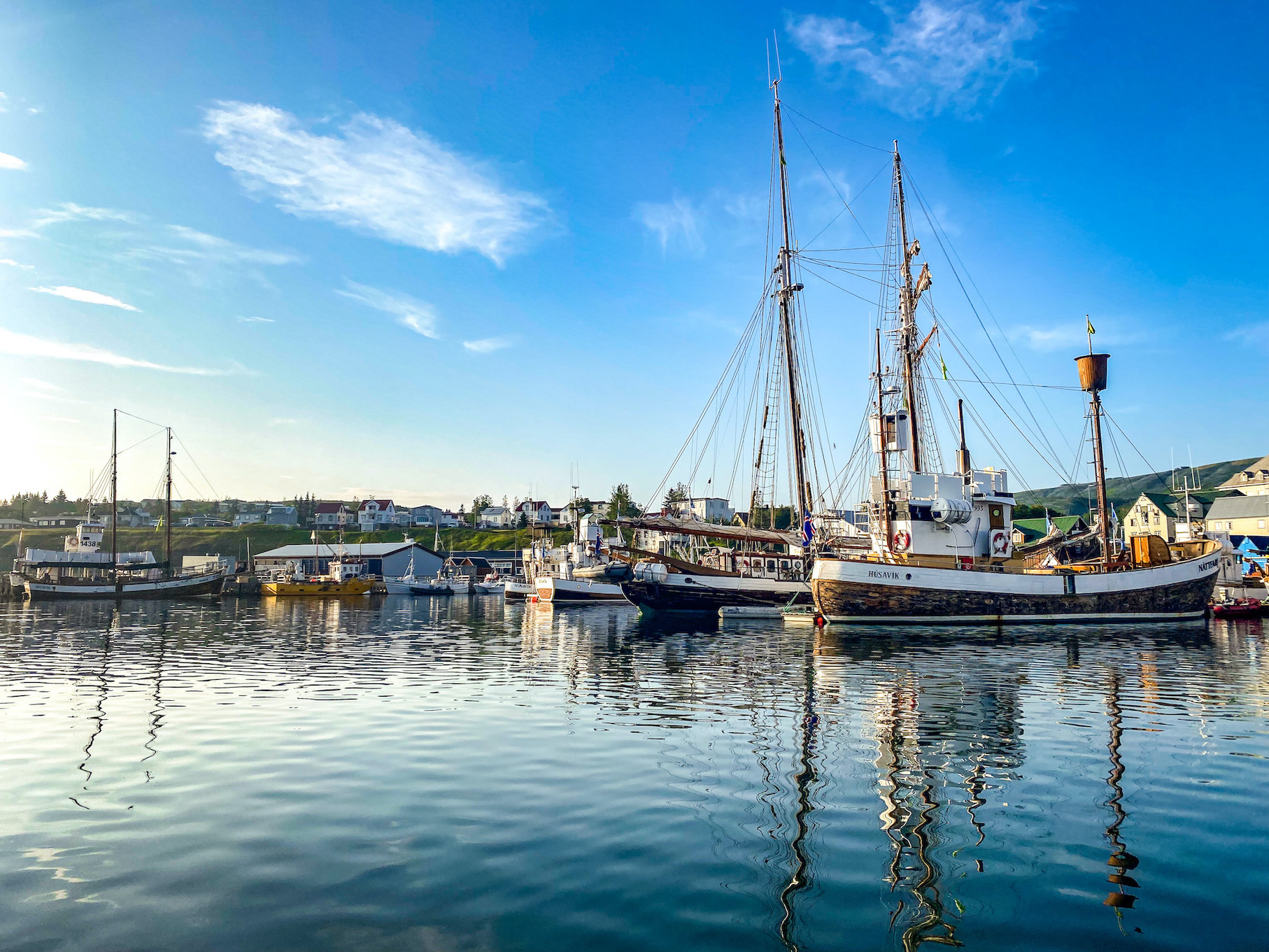
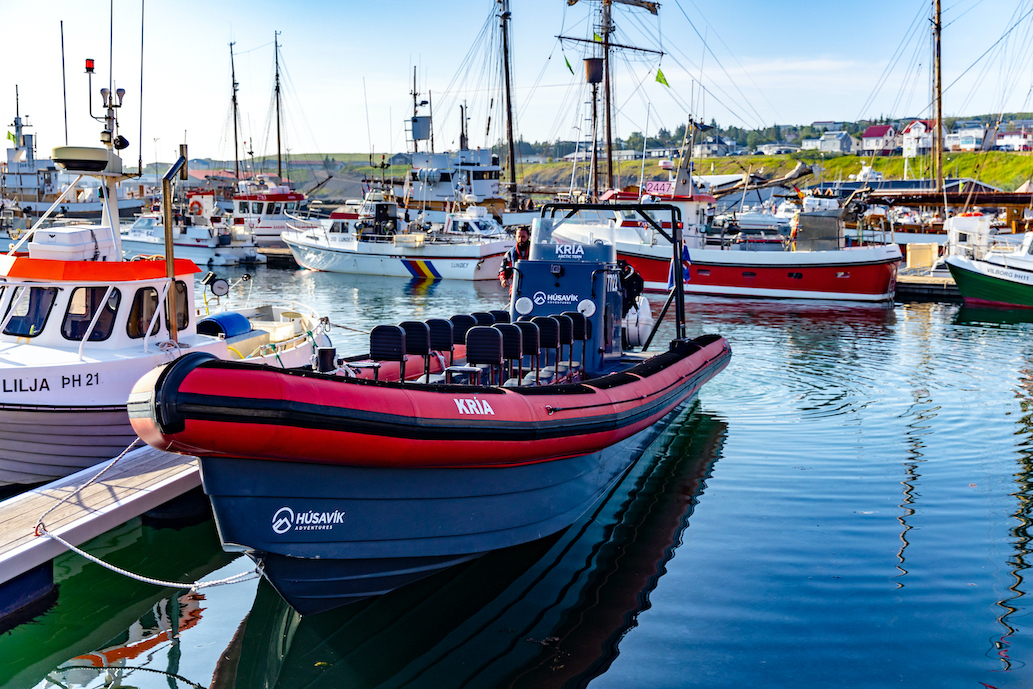
Los geht die Tour am Hafen von Husavik mit einem Safety Briefing, bei dem alle Gäste der Whale Watching Tour auf wichtige Verhaltensregeln hingewiesen werden. Nachdem wir die Hafenausfahrt verlassen hatten, gibt der Kapitän Gas Richtung Lundey – auch Puffin Island genannt – wo Zehntausende der witzigen Papageitaucher nisten, leben und jagen. In respektvollem Abstand beobachten wir die drolligen Vögel, die ein Gesicht wie ein Clown haben. Nach einigen Minuten verlassen wir die küstennahe Insel und fahren Richtung Ausgang der Skjálfandi Bucht – immer im Schatten der großartigen Kulisse der schneebedeckten Berge an der Westseite der Bucht.
Nun geht es Schlag auf Schlag. Unser Guide sieht die ersten Meeressäuger und wir nähern uns behutsam einer Gruppe Minkwale. Minkwale sind mit unter zehn Metern Länge relativ kleine Vertreter der Bartenwale. Einige Zeit folgen wir der Gruppe und können gute Bilder schießen, bevor die Minkwale abtauchen und verschwinden.
Nach einigen Minuten in der Bucht entdecken wir zwei Weißschnauzendelfine – eine Mutter mit Kind, die im Parallelflug vor oder neben uns her schwimmen.
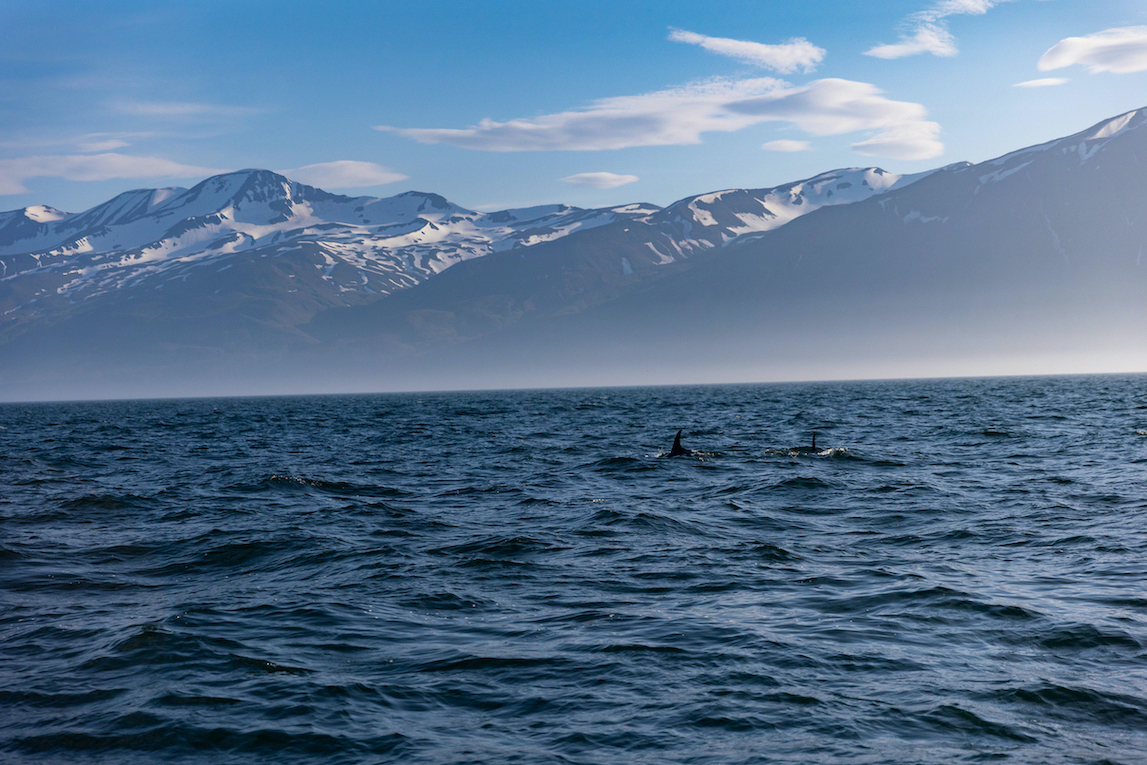
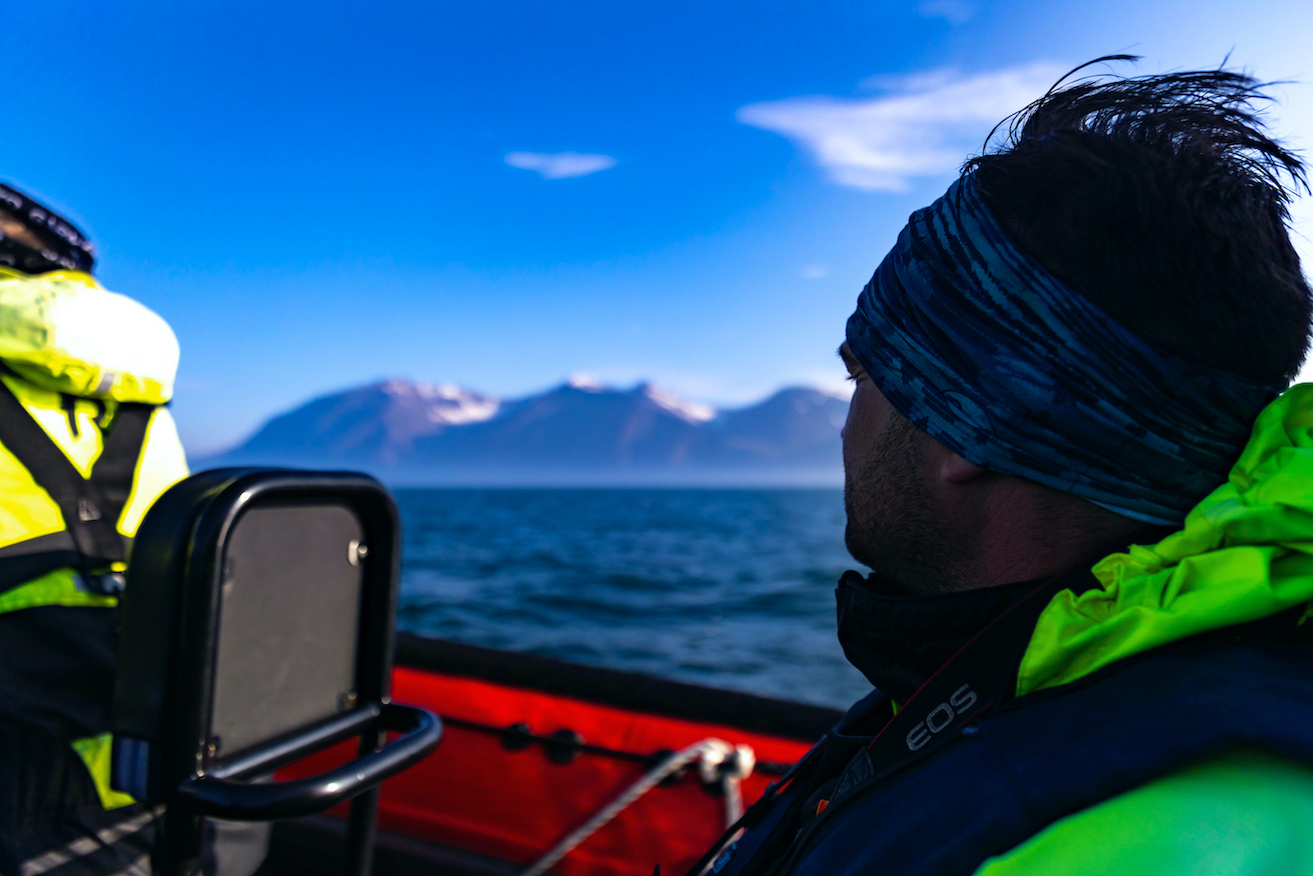
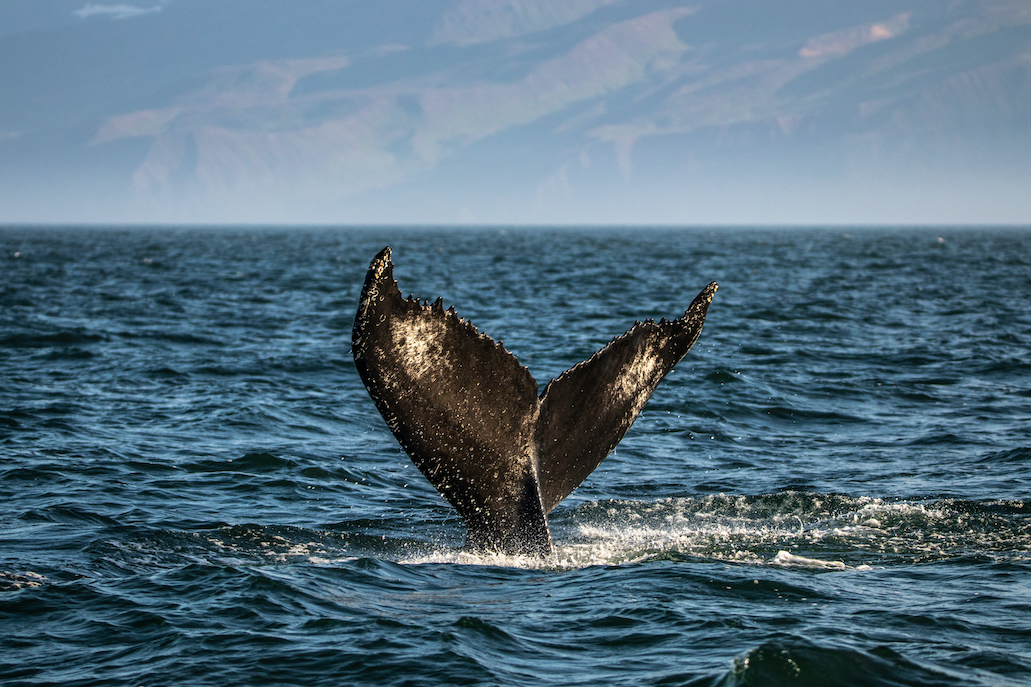
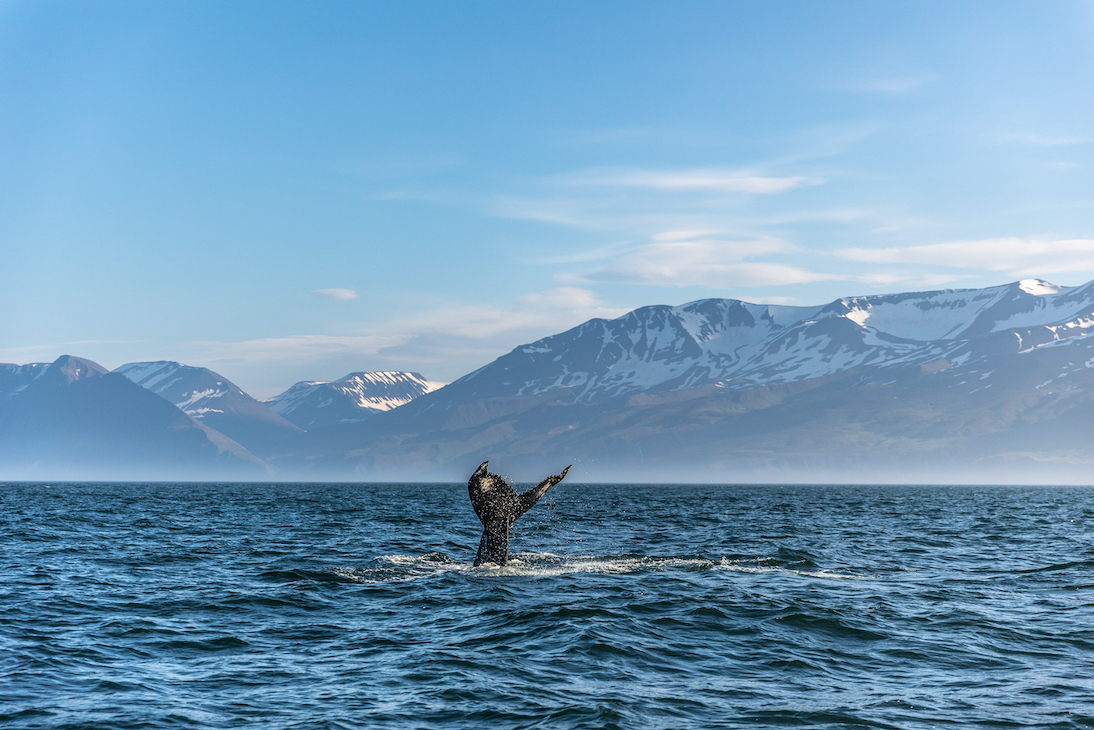
Wenn ihr die Papageientaucher von nächster Nähe sehen möchtest, dann müsst ihr ein paar Kilometer weiter gen Norden fahren. Dabei kommt ihr an tollen Aussichtspunkten vorbei. Wir haben am Parkplatz des Cliff Viewpoint von Hringsbjarg geparkt und sind dann mit Kamera und Stativ an den Klippen entlang gegangen. Dort sind die Papageientaucher an den Felswänden zu finden.
Hotelvorschlag als Alternative zum Camper: Moderne Wohncabins mit unfassbarem Ausblick*

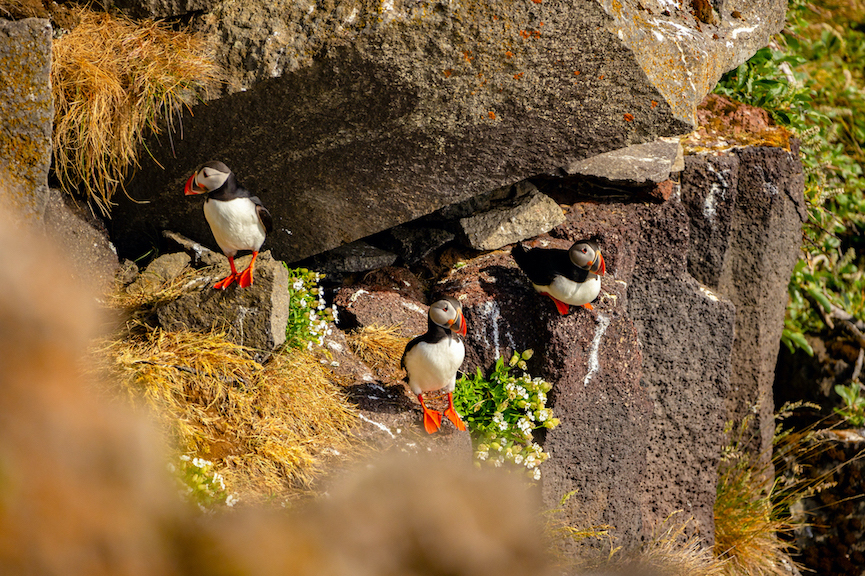
Vök Baths
Ein weiteres Highlight auf unserer Island Rundreise mit dem Camper war das Vök Baths [anzeige] in der Nähe des Ortes Fellabaer. Dabei handelt es sich um ein Thermalbad am Seeufer des Urriðavatn. Der Eintritt kostet 5.500 ISK und solltet ihr online im Voraus buchen*.
Vök ist das Isländische Wort für „Eisfreie Fläche auf einem zugefrorenen See“ und genau das ist auch der Ursprung von Vök Baths. Aufgrund von Hotsprings und Thermalquellen unter dem See, entstehen auf dem See eisfreie Flächen im Winter. Das Design der ganzen Anlage basiert auf dieser Tatsache und dem Konzept der absoluten Nachhaltigkeit. Dazu zählen die Verwendung von heimischen Baumaterialien wie Holz und Stein, der Verzicht auf Single-Use-Plastic und totaler Respekt gegenüber der Natur.
Das Hauptgebäude ist so gut in die Umwelt integriert, dass man es kaum wahrnimmt.
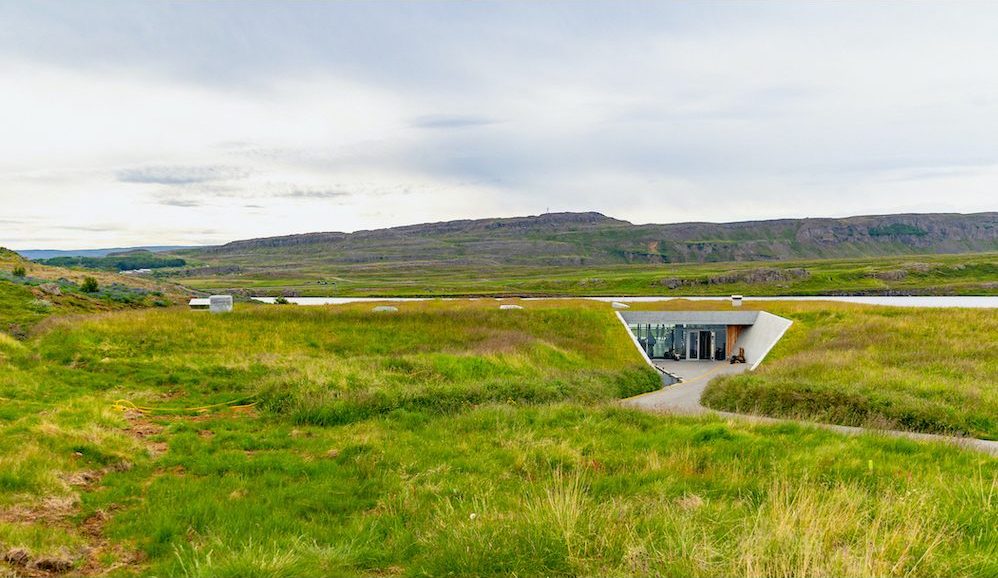
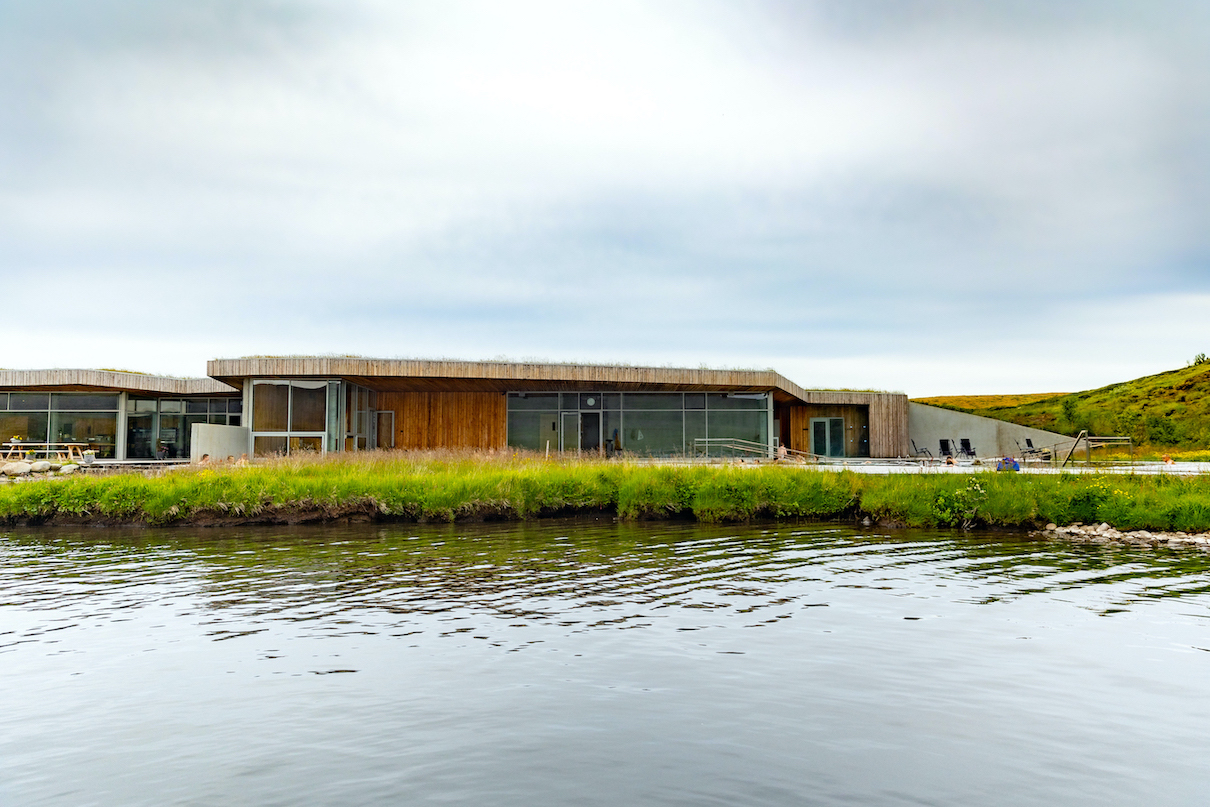
Einmal drinnen fällt sofort das luxuriöse Design auf. Dominierend sind schwarzer Stein und Holz in einer sehr geschmackvollen Kombination. Der Architekt hat hier ganze Arbeit geleistet. Der Umkleidebereich ist richtig einladend. Überall stehen Bodylotion, Shampoo und Duschgel mit Birken Fragrence zur Verfügung. Am Eingang bekommt ihr ein Armband, das sowohl als Schlüssel für den Spind als auch fürs Zahlen an der Poolbar genutzt wird.
Nach einer warmen Dusche geht es raus ins Freie – entweder durch eine Tür oder durch ein kleines Swim-Out ins Hauptbecken. Das Hauptbecken liegt direkt ans Gebäude angrenzend noch auf Land. Es gibt mehrere Stehtische im Becken und Bänke an den Rändern des Beckens. Hier ist auch die Poolbar, wo ihr Bier, Wein oder Cocktails aber auch alkoholfreie Getränke bestellen könnt und im warmen Wasser genießen könnt. Der Preis für ein Bier liegt um die 1000 ISK.
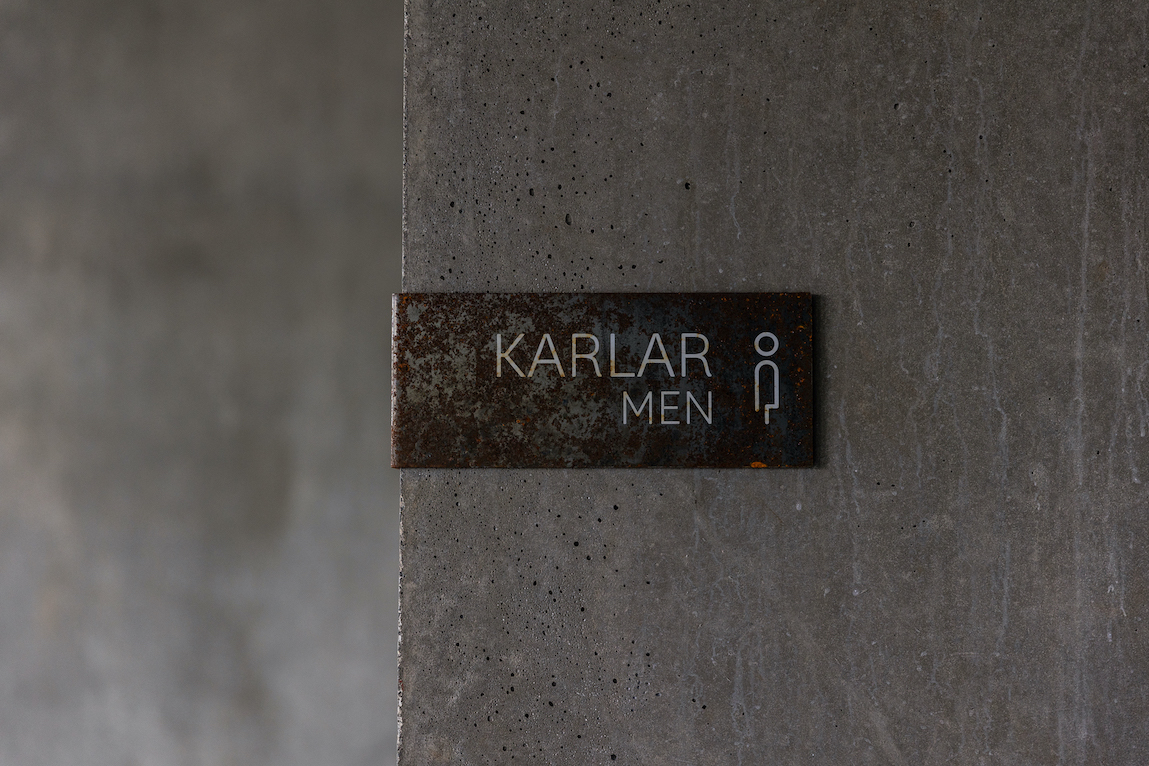

Wir haben den Tag sehr genossen und können das Vök Baths wirklich empfehlen.
Hotelvorschlag als Alternative zum Camper: Schnell sein und früh buchen – oft ausgebucht*
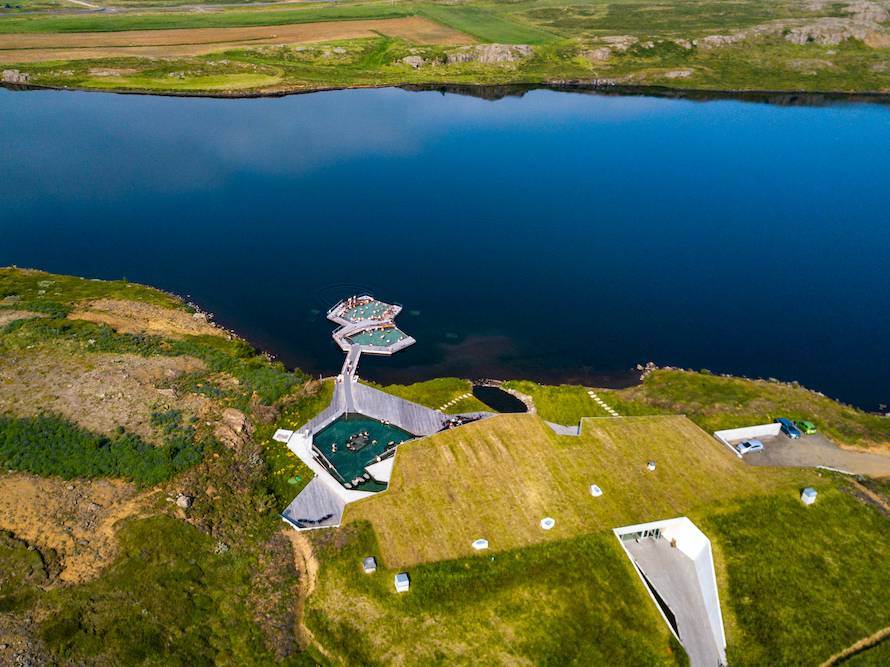
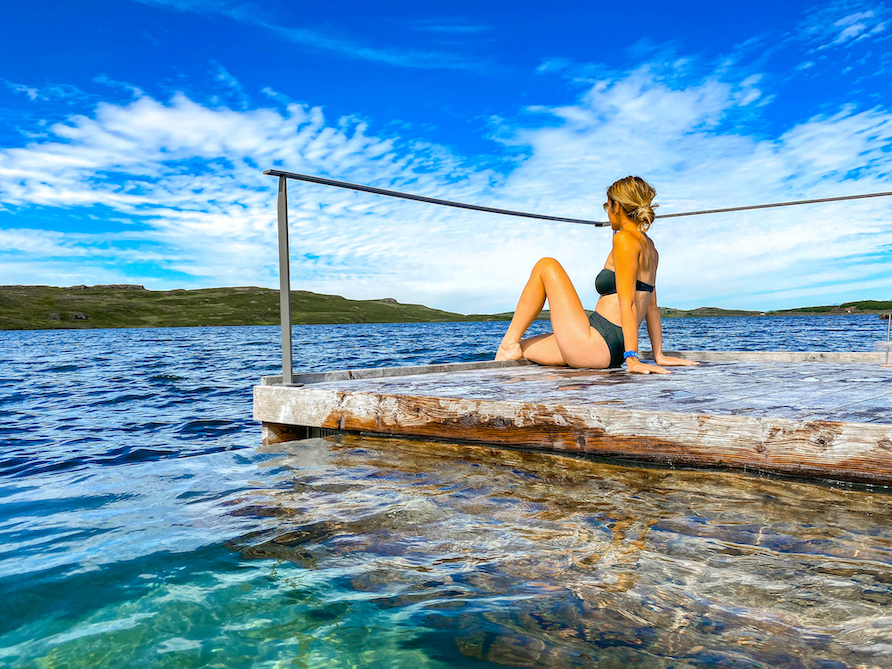
Wasserfälle in Island
Gulfoss Wasserfall auf Island
Der Gulfoss Wasserfall ist sicher einer der mächtigsten auf Island. Hier bricht sich ein mächtiger Fluss den Weg durch die Felsen und stürzt in die Tiefe. Hat uns von der Art her etwas an die Viktoria Falls erinnert – wenn auch deutlich kleiner. Am Gulfoss gibt es zwei Parkplätze – einer direkt an der Kante des Wasserfalls, der andere etwas erhöht gelegen. Wir haben den unteren genommen. Von dort sind es etwa fünf Minuten einfacher Fußweg zur Aussichtsplattform direkt an der Wasserfallkante. Denkt daran, euer Kameraequipment zu schützen, denn auf dem Weg dorthin lauft ihr durch leichten Sprühregen.
Einmal auf der Plattform angekommen, bestaunt ihr die gewaltigen Wassermassen aus direkter Nähe. Wirklich sehr beeindruckend. Im Sommer ist das Licht gegen abends optimal für schöne Bilder. 30 Minuten vor Ort sollten den meisten reichen. Da ihr hier noch voll im Golden Circle seid, sind auch immer wieder Busse vor Ort und der Gulfoss ist im Gegensatz zu den Wasserfällen im Osten und Norden relativ stark besucht. Angeblich gibt es auch einen Weg auf die andere Seite des Wasserfalls, wo man die Schönheit von Gulfoss alleine genießen kann. Das haben wir aber erst nach unserem Besuch dort erfahren. Wenn ihr den Weg kennt oder gefunden habt, sagt uns auf Instagram Bescheid.
Hotelvorschlag als Alternative zum Camper: Perfekte Ausgangslage für Gulfoss, Geysir, Landmannalaugar und Silfra Spalte*

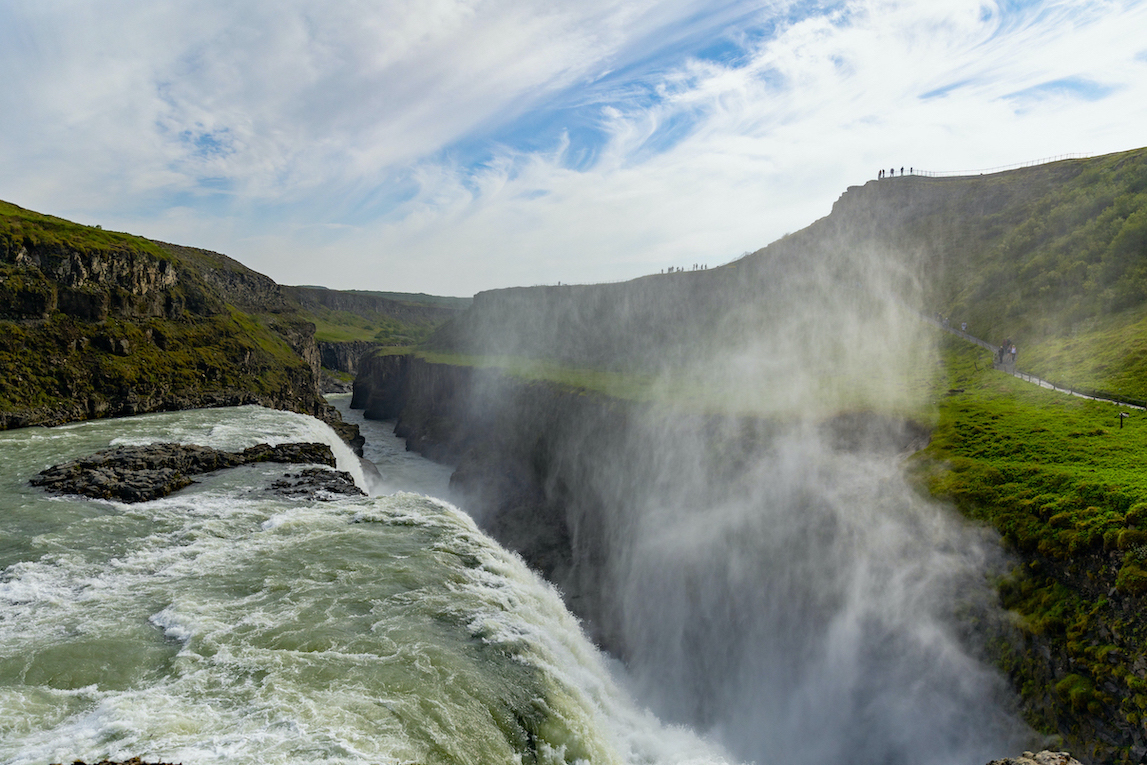
Seljalandsfoss mit Gljiu Frabui
Der Seljalandsfoss gehört sicher zu den meistfotografierten Wasserfällen Islands und das völlig zurecht. Parken am Seljalandsfoss kostet 700 ISK, deswegen empfiehlt es sich besser gleich eine Nacht am Campingplatz neben dem Wasserfall zu bleiben, falls ihr mit dem Camper durch Island reist. Wasserfeste Kleidung ist auch an Tagen mit schönem Wetter von Vorteil, denn die Gischt um den Wasserfall herum durchweicht die Kleidung recht schnell. Denkt auch an einen Schutz für Kamera und Smartphone – vor allem, wenn ihr hinter dem Wasserfall durchgehen möchtet. Und das solltet ihr auf jeden Fall machen, denn es gibt nicht viele Wasserfälle, wo das möglich ist. Geht den kleinen Rundweg um den Wasserfall gegen den Uhrzeigersinn, denn dann müsst ihr die nassen und rutschigen Felsen links des Wasserfalls nicht bergab gehen, sondern könnt aufsteigen, was deutlich entspannter ist. Denkt auch an vernünftige Schuhe, denn durch die ständige Gischt ist es immer nass und die Felsen sind teilweise mit Moos und Schlamm überzogen. Im Juli blüht die kleine Wiese vor dem Wasserfall richtig schön und ihr könnt super Fotos schießen. Vor allem in den Abendstunden ist das Licht magisch. Vor Ort sollten euch 30 bis 60 Minuten ausreichen.
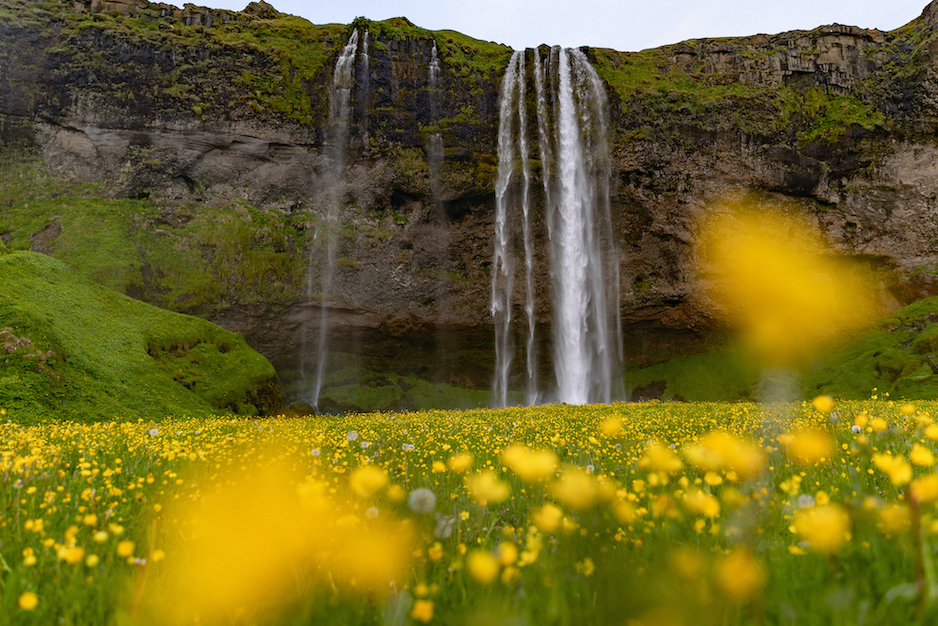
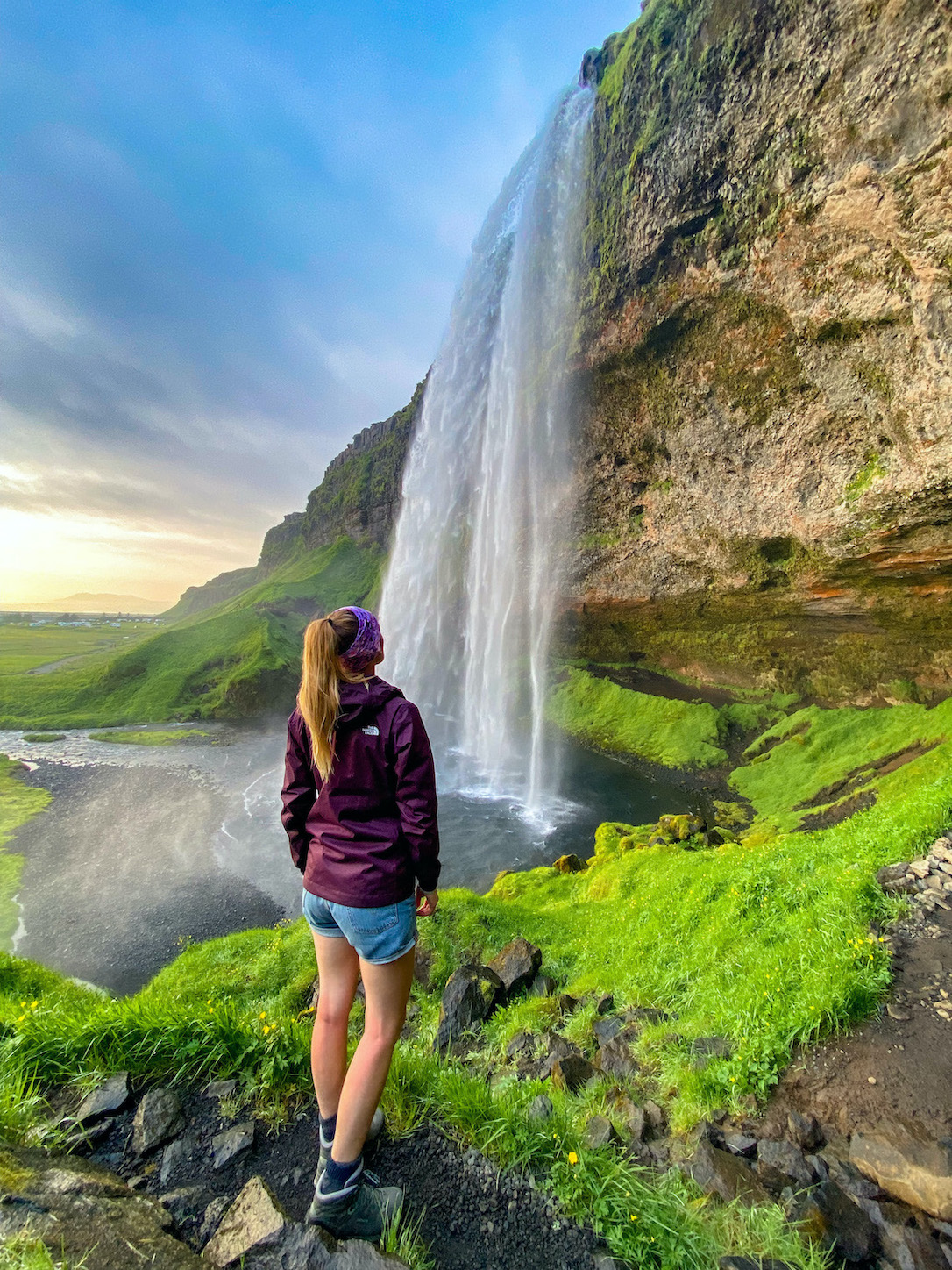
Etwas abseits des berühmten Seljalandsfoss versteckt sich in einer nach oben geöffneten Höhle mit dem Wasserfall Gljúfrabúi sein kleiner Bruder, der uns sogar noch etwas besser gefallen hat. Die Höhle liegt direkt oberhalb des Campingplatzes und ist nicht direkt einsehbar. Auch hier solltet ihr regenfeste Kleidung haben, denn in der Höhle „regnet“ es immer. Länger als zehn Minuten müsst ihr für diesen Wasserfall nicht einplanen, denn dann seid ihr vermutlich komplett nass.
Hotelvorschlag als Alternative zum Camper: Perfekt für Seljalandsfoss, Skogafoss, Rejnisfjara und Fjaðrárgljúfur*
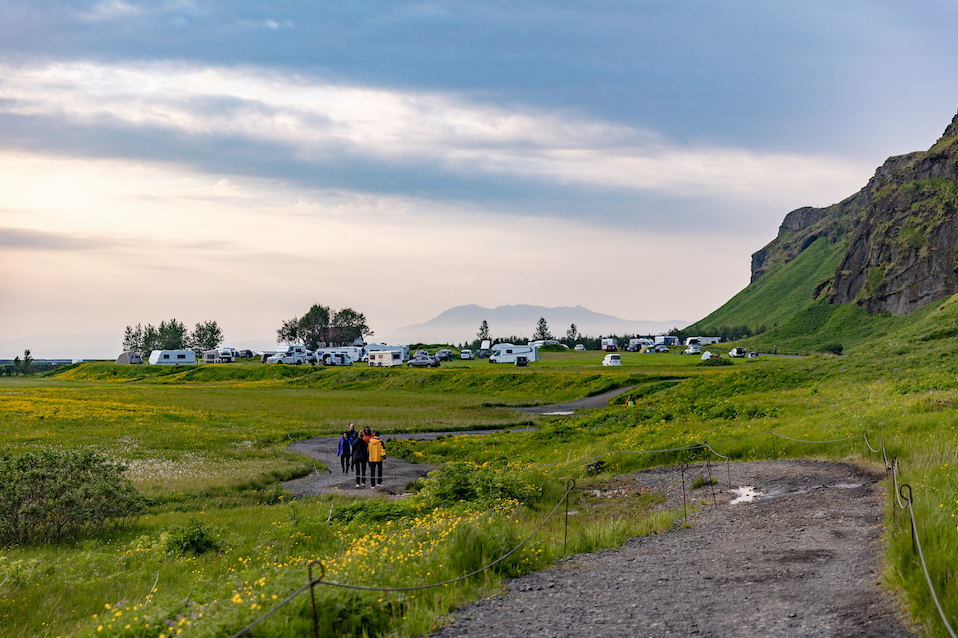
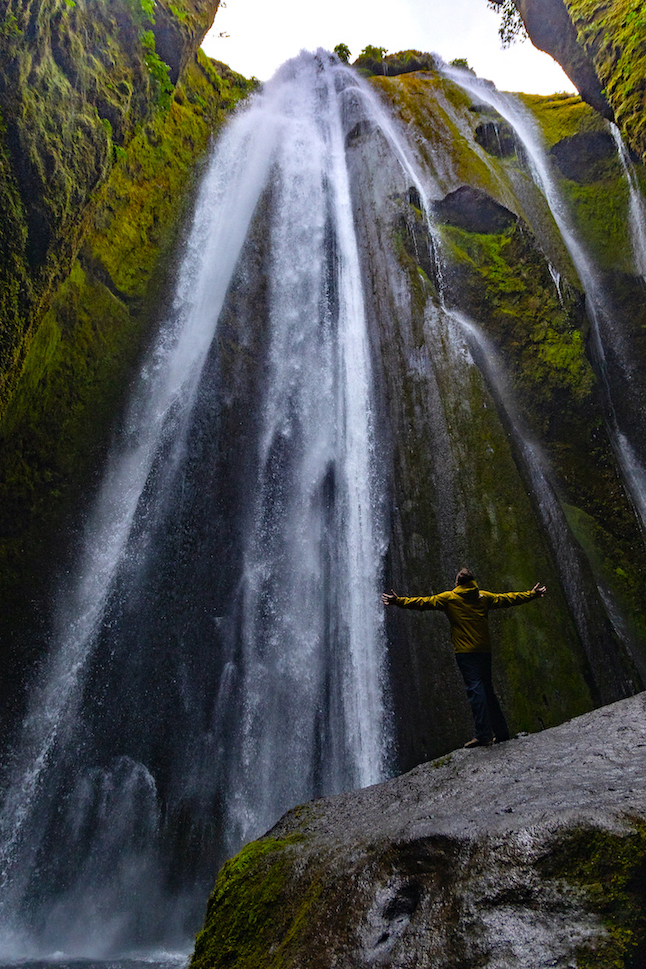
Skogafoss
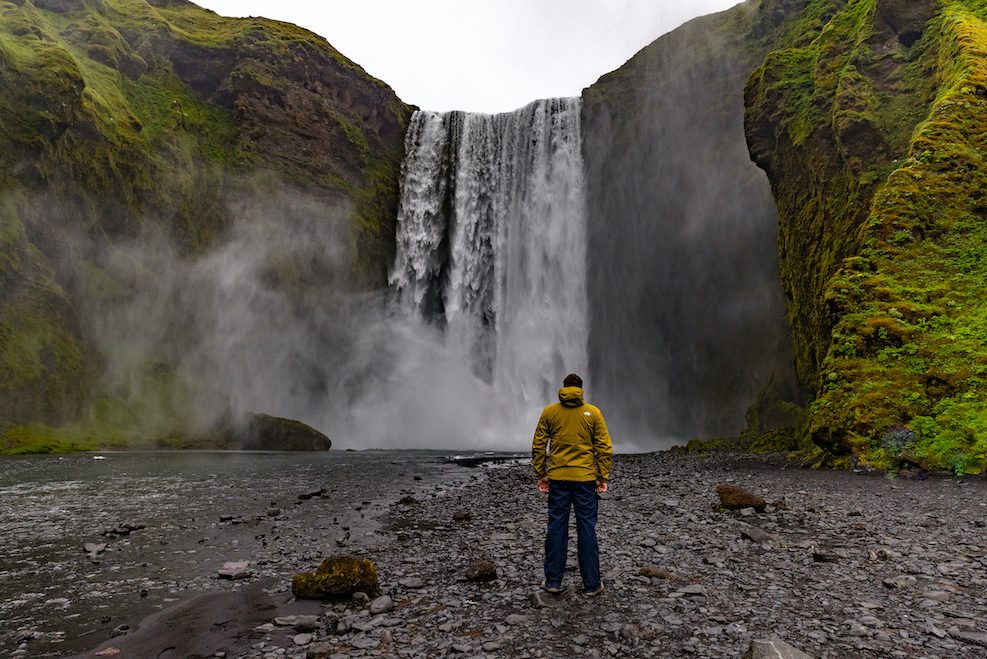
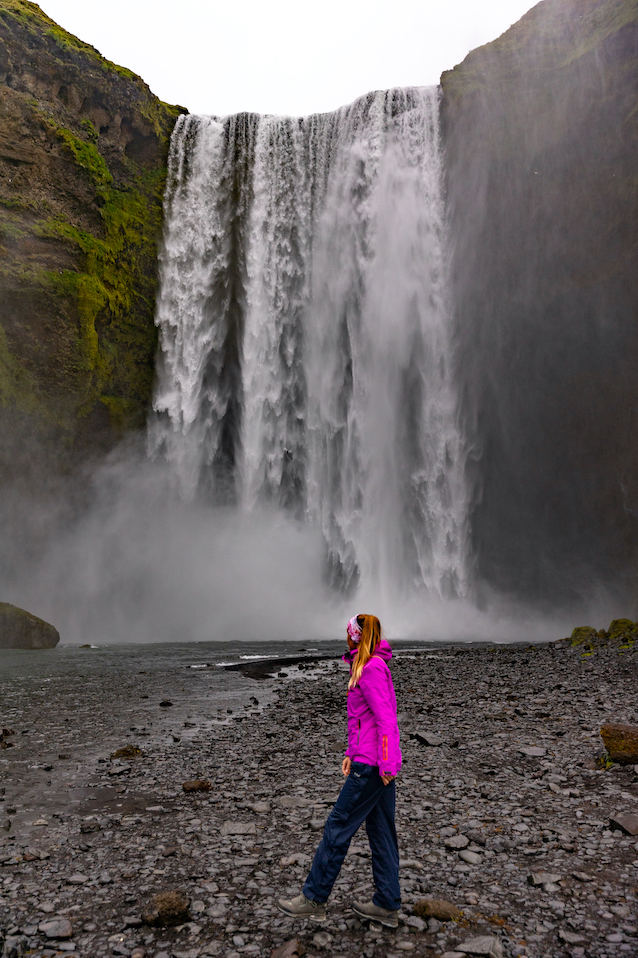
Svartifoss Wasserfall im Nationalpark mit Skaftafell
Der Svartifoss Wasserfall im Südosten von Island fällt malerisch vor einer symetrischen Basaltwand herunter. Schöner könnte ein Wasserfall nicht sein. Der Wasserfall ist aber nur eines der Highlights im Skaftafell Nationalpark. Schneebedeckte Berggipfel, eine mächtige Gletscherzunge und ein gigantischer Gletschersee, in dem Eisberge schwimmen. Wir haben dazu die Wander-Route S6 im Skaftafell Nationalpark genommen. Das waren etwa 350 Höhenmeter , 8,5 Kilometer Strecke und knapp drei Stunden Dauer. Sucht euch die für euch passende Route einfach am Visitor Center aus. Der Parkplatz kostet 750 ISK. Hier gibt’s auch Toiletten und einen Foodtruck.
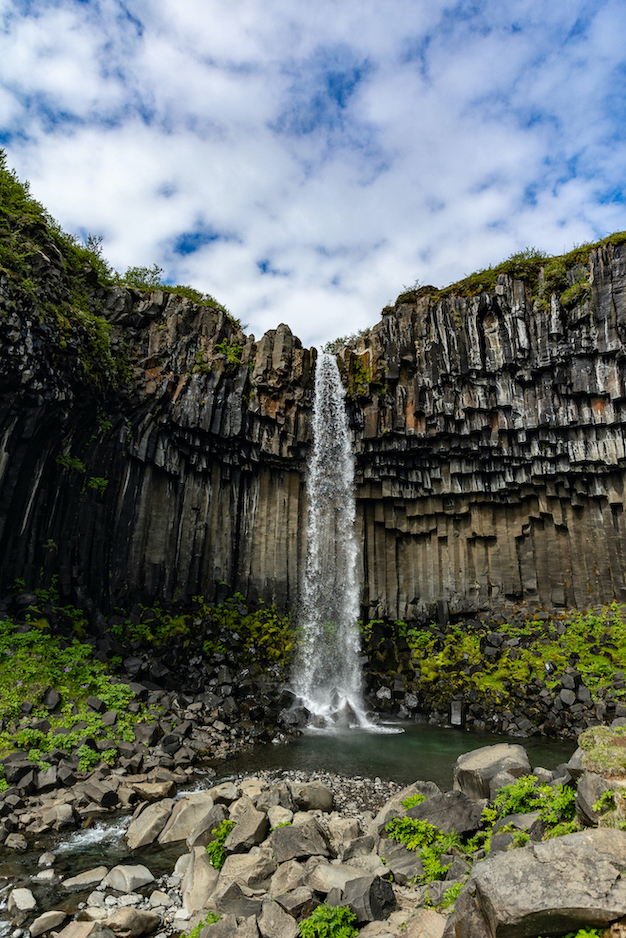
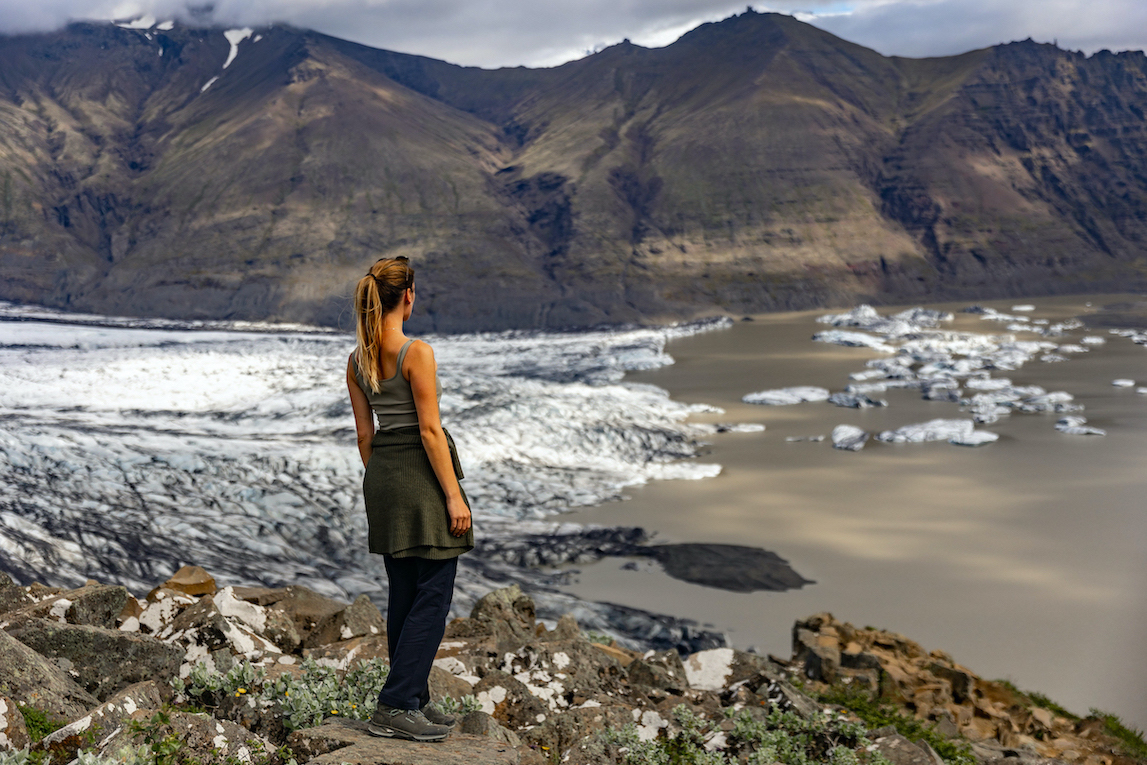
Hengifoss Wasserfall
Der Hengifoss liegt ganz im Osten von Island und ist unserer Meinung nach einer der schönsten Wasserfälle der Insel. Der Wasserfall fällt von einem Hochplateau in einen zu einer Seite offenen Trichter, der durch seine verschiedenen geologischen Schichten gestreift wirkt. Optisch wirklich ein Highlight. Ihr parkt am kostenlosen Hengifoss Carparking direkt neben dem See Lagarfljót und steigt etwa 45 Minuten auf einem gut befestigten Weg auf. Dabei kommt ihr am Basalt-Wasserfall Litlanesfoss vorbei, der auch ein tolles Fotomotiv abgibt. Ihr geht aber weiter bis ihr auf einen hölzernen Pfad kommt. Nach wenigen Minuten stoßt ihr auf einen Bach, dem ihr folgt bis ihr den mächtigen Hengifoss Wasserfall seht. Je nach Jahreszeit und Wasserstand ist es möglich den Bach zu überqueren und bis in den Trichter des Wasserfalls einzusteigen. Der Blick auf den Hengifoss ist wirklich grandios. Die gesamte Wegstrecke ist um die fünf Kilometer lang. Dabei erklimmt ihr 265 Höhenmeter. Mit Brotzeitpause am Hengifoss Wasserfall solltet ihr mindestens zwei Stunden vor Ort einplanen.
Hotelvorschlag als Alternative zum Camper: Schnell sein und früh buchen – oft ausgebucht*
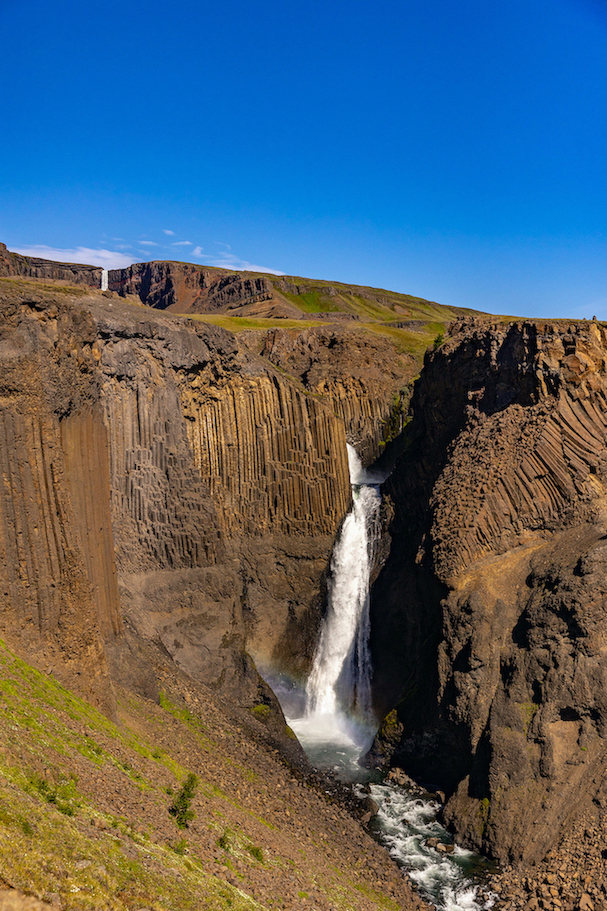
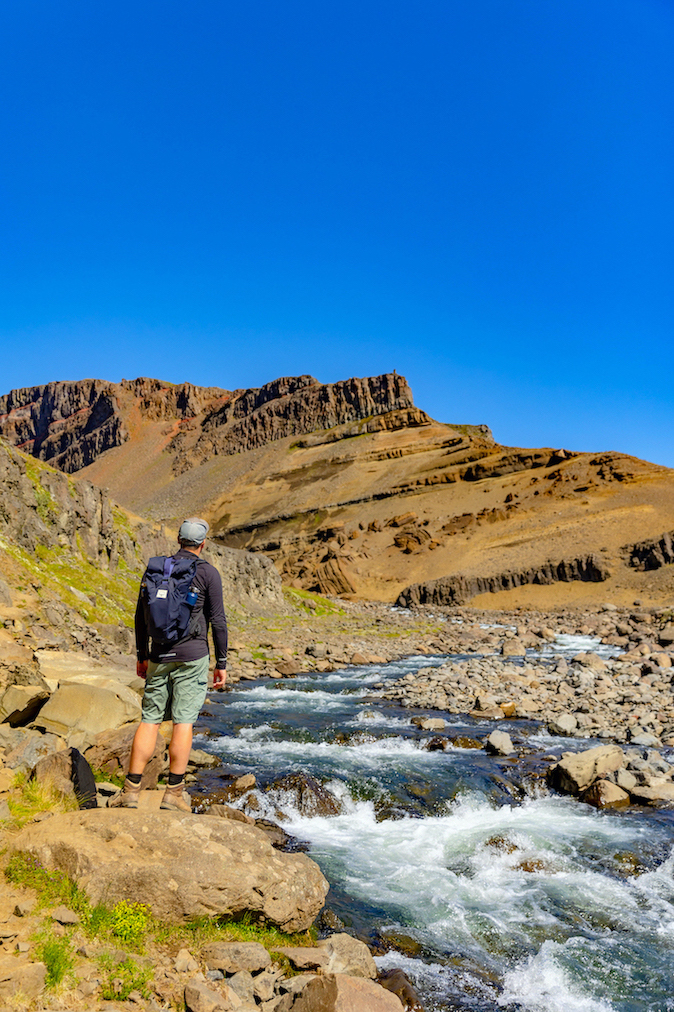
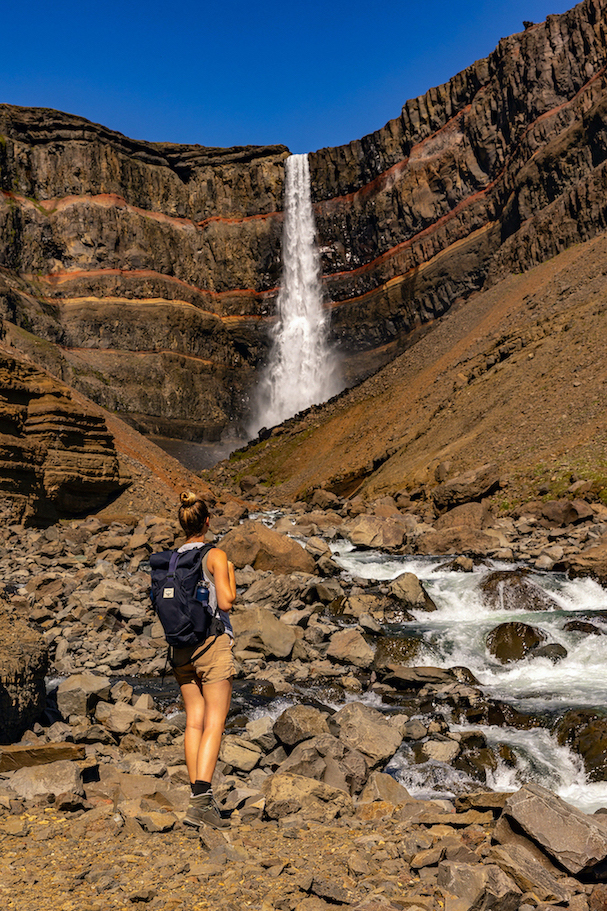
Godafoss
Godafoss – der Wasserfall der Götter – ist von der Straße bzw. vom kostenlosen Parkplatz aus in fünf Minuten zu erreichen und beeindruckt durch seine Wassermassen. Er wirkt etwas wie ein Miniatur-Niagarafall. Für uns einer der weniger interessanten Wasserfälle auf Island.
Hotelvorschlag als Alternative zum Camper: Moderne Wohncabins mit unfassbarem Ausblick*
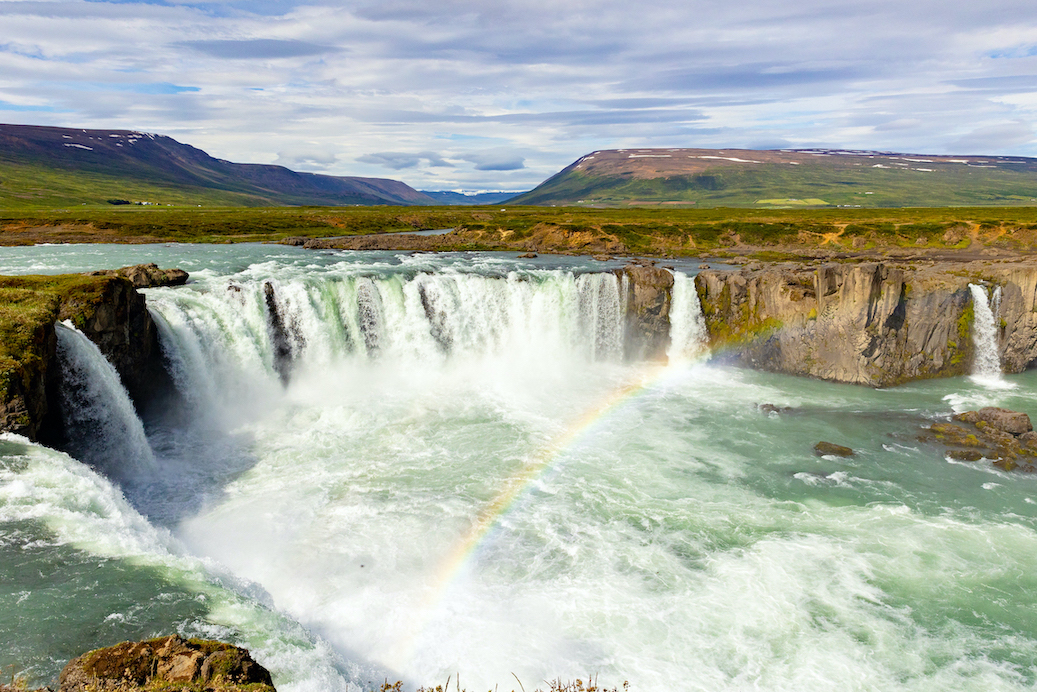
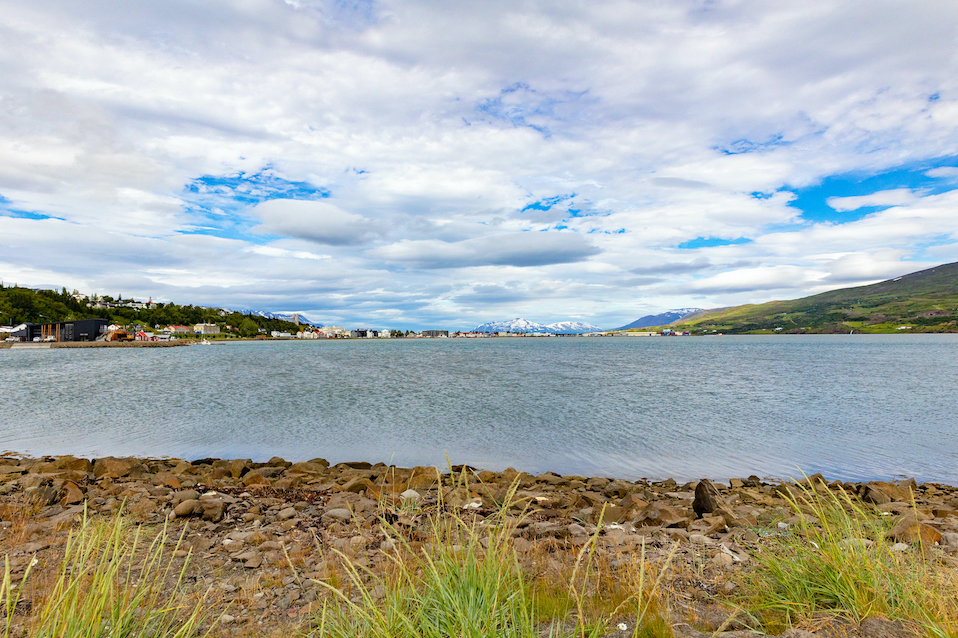
Kirkjufellsfoss
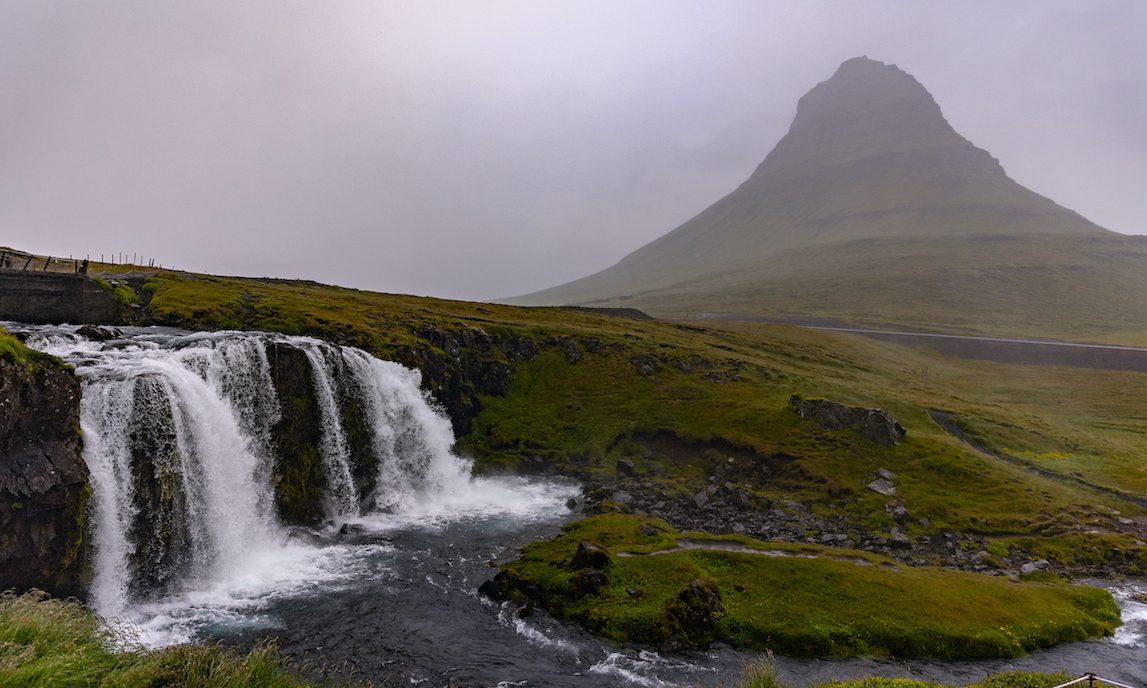
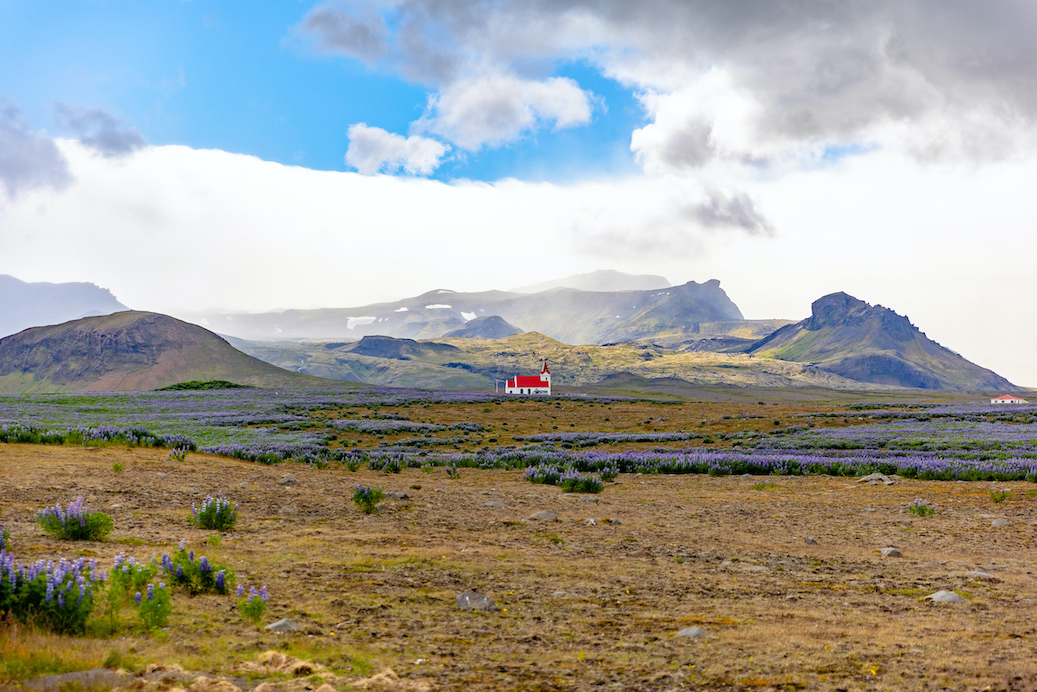
Der Vulkan Fagradalsfjall (Geldingadalir)
Anfang des Jahres 2021 war der Vulkan Geldingadalir weltweit in allen Medien. Das Besondere ist, dass man bis vor kurzem sehr nahe an den Lava spuckenden Krater ran konnte. Mittlerweile sind die Wege zum Kraterschlund von erstarrter, aber noch sehr heißer Lava überzogen, sodass ihr euch nicht mehr näher als einige Hundert Meter ran könnt. Das macht aber nichts, denn auch von der Entfernung ist der Feuer-spuckende Vulkan unfassbar beeindruckend.
Der Vulkan spuckt auch nicht jeden Tag zu jeder Zeit. Deshalb schaut auf jeden Fall auf die Webcams, die ihr auf YouTube findet. So fahrt ihr nicht umsonst hin. Wir haben in der Nacht unserer Anreise den Geldingadalir vom Flugzeug aus Lava spucken sehen und sind am nächsten Morgen sofort hingefahren. Leider haben wir nicht mehr als eine kleine Rauchfahne gesehen. Am Ende unserer Island Rundreise haben wir noch einen Versuch gestartet. Am Morgen haben wir nochmal die Webcams gecheckt. Dort haben wir gesehen, dass der Vulkan an diesem Tag sehr aktiv war und es hat sich absolut gelohnt.
Es gibt drei Parkplätze – alle etwa zehn Kilometer östlich von Grindavik – direkt an der Straße. Ihr könnt sie eigentlich nicht verfehlen. Der erste Parkplatz von Grindavik aus gesehen ist relativ weit weg vom Vulkan, sodass ihr einen langen Fußweg zurücklegen müsst.
Der zweite Parkplatz kostet eine Gebühr von 1000 ISK, die ihr online über eine Website zahlen müsst. Hier gibt es auch Toiletten und einen Foodtruck.
Der dritte Parkplatz von Grindavik aus kostet keine Gebühr und ist etwa gleich weit wie der Zweite vom Vulkan entfernt. Hier gibt es keine Toiletten und keinen Verkaufsstand.
Den ersten Parkplatz haben wir nicht benutzt. Die anderen beiden schon.
Von allen Parkplätzen kommt ihr aber zu den rauchenden Lavaausläufern hin ohne eine nennenswerte Steigung bewältigen zu müssen.
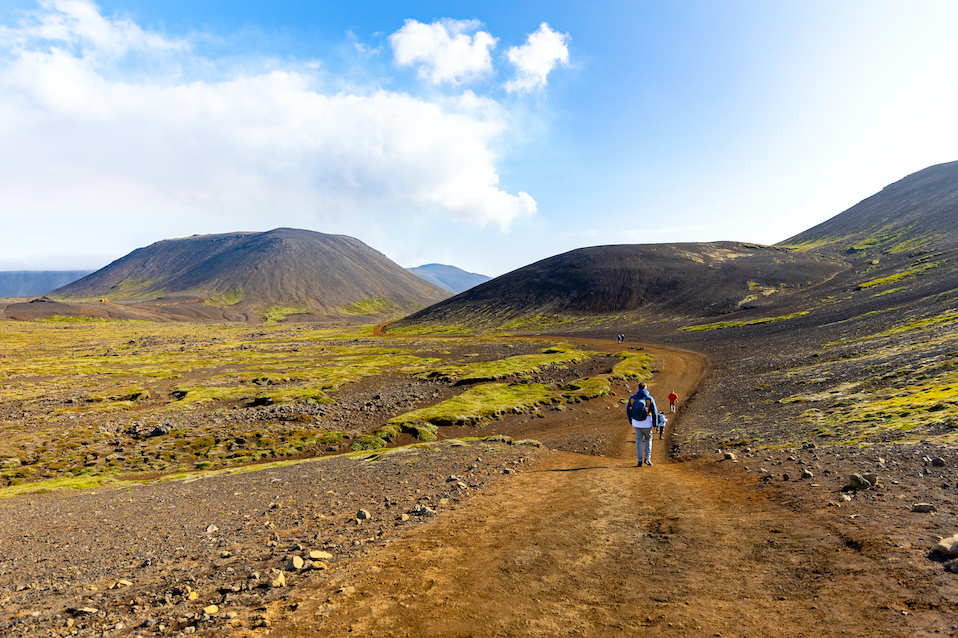
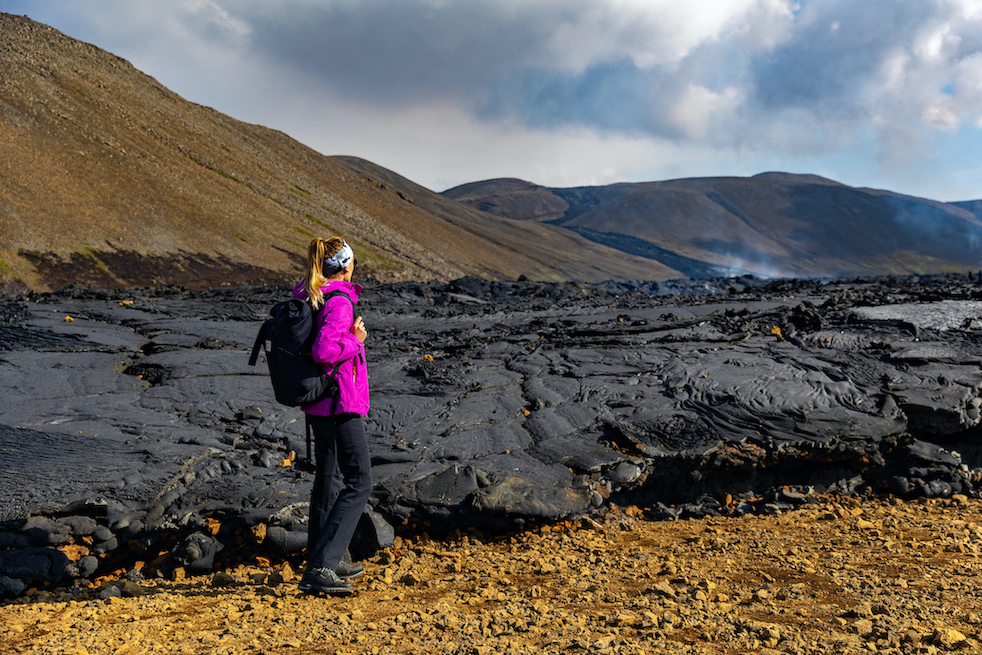
Ergänzung:
Anfang 2022: Der Vulkan ist nicht mehr mehr aktiv, kann aber weiterhin besucht werden.
August 2022: Der Fagradalsfjall ist im August 2022 wieder ausgebrochen.
Juli 2023: Der Fagradalsfjall ist am 10. Juli 2023 erneut ausgebrochen. Aus einer 900 Meter langen Erdspalte beim Litli-Hrútur Gipfel quilt glühende Lava mit hoher Fließgeschwindigkeit. Hier findet Ihr Live Webcams für den Ausbruch des Fagradalsfjall.
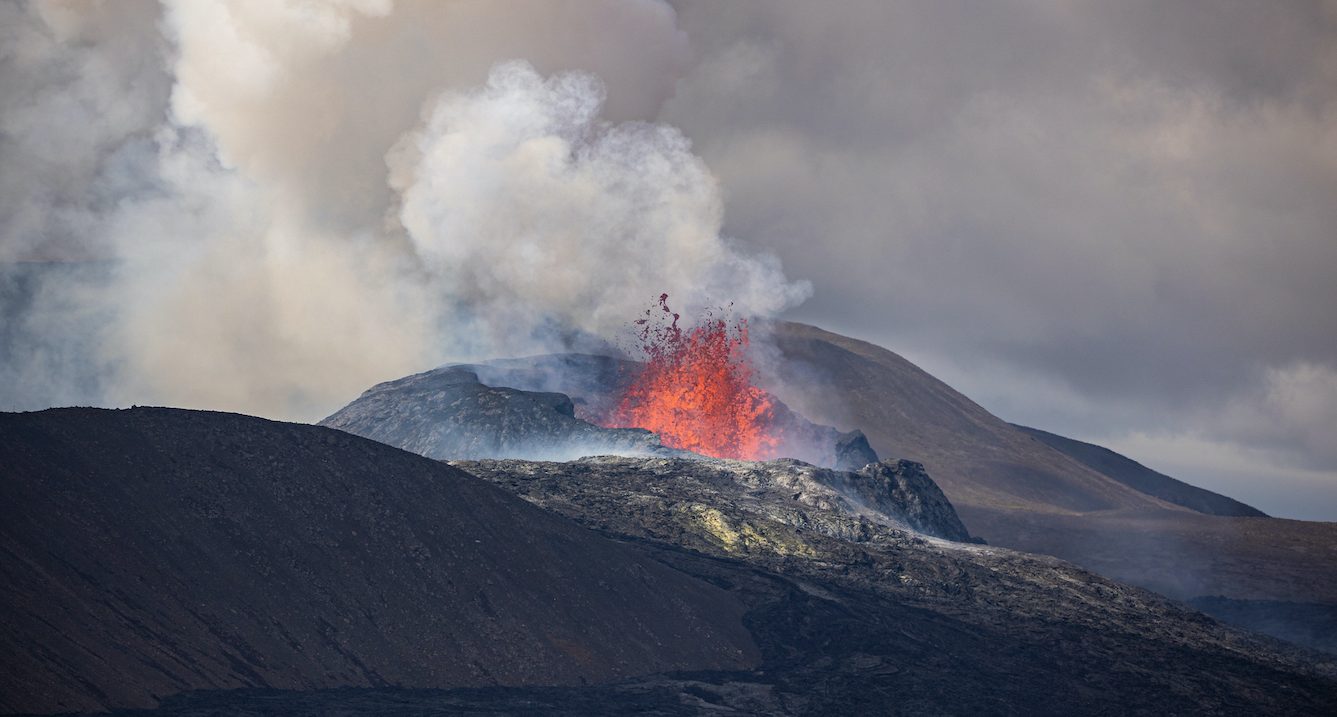
Landmannalaugar und das Hochland von Island
Eines unserer absoluten Highlights auf Island war Landmannalaugar und das Hochland. Wenn ihr mit einem Campervan durch Island reist, dann verpasst nicht die Gelegenheit eine oder mehrere Nächte im Hochland zu verbringen. Dafür braucht ihr aber einen Allradantrieb. Bei uns hat das mit unserem 4×4 mit Dachzelt von Icenrental super geklappt. Die Strecken nach Landmannalaugar und zu anderen Orten im Hochland sind nur im Hochsommer befahrbar und auch dann nur mit einem 4WD.
Nach Landmannalaugar gibt es drei F-Roads. Die Straße Landmannaleið, die von der Straße 26 abzeigt sowie die Anfahrt über die F208 von Süden oder über die F208 von Norden her. Mit unserem Dacia Duster war Anfang Juli nur die F208 von Norden her passierbar. Für die anderen beiden Optionen hätten wir ein schwereres Fahrzeug benötigt. Wir beschreiben euch also hier die Anfahrt über die F208 von Norden her.
Dazu fahrt ihr auf der Straße 26 oder 32 bis ihr auf die F26 trefft. Dort fahrt ihr weiter bis zur Abzweigung in die F208. Kurz vor der Abzweigung kommt auch noch die letzte Tankstelle vor Landmannalaugar. Verlasst euch aber nicht auf diese Tankstelle, in den Highlands sollte man immer ein Backup haben. Ihr biegt also in die F208 ein und hier beginnt der Spaß. Die Straße ist nicht mehr asphaltiert. Der Untergrund ist mal steinig, mal weicher Lavasand. Es macht auf jeden Fall unheimlich viel Spaß hier mit dem passenden Auto zu fahren.
Auch die Umgebung ist der Hammer. Die spektakulären Fotospots überbieten sich gegenseitig an Schönheit und Besonderheit. Zum einen kommt ihr am See Frostastaðavatn vorbei, der wirklich wunderschön ist. Vom Licht her solltet ihr den See am besten morgens – auf der Hinfahrt vielleicht – besuchen. Auf der Rückfahrt solltet ihr auf alle Fälle einen Stopp bei Kratersee Bláhylur machen. Absolut spektakulär. Das Handynetz ist übrigens fast durchgehend gut hier draußen.
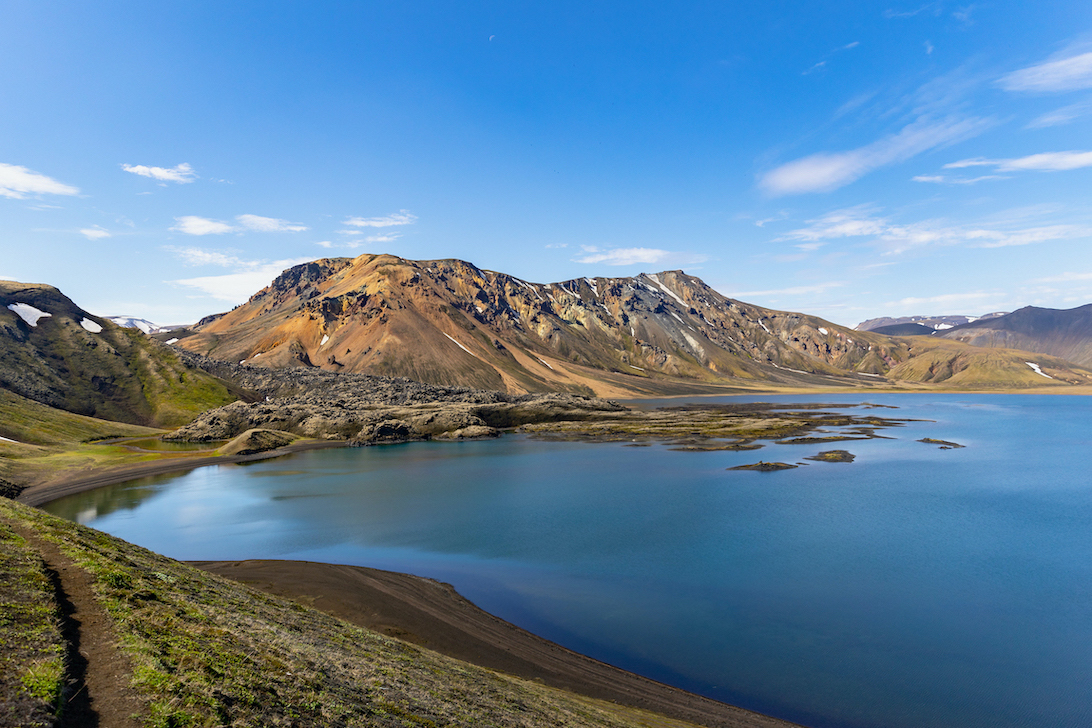
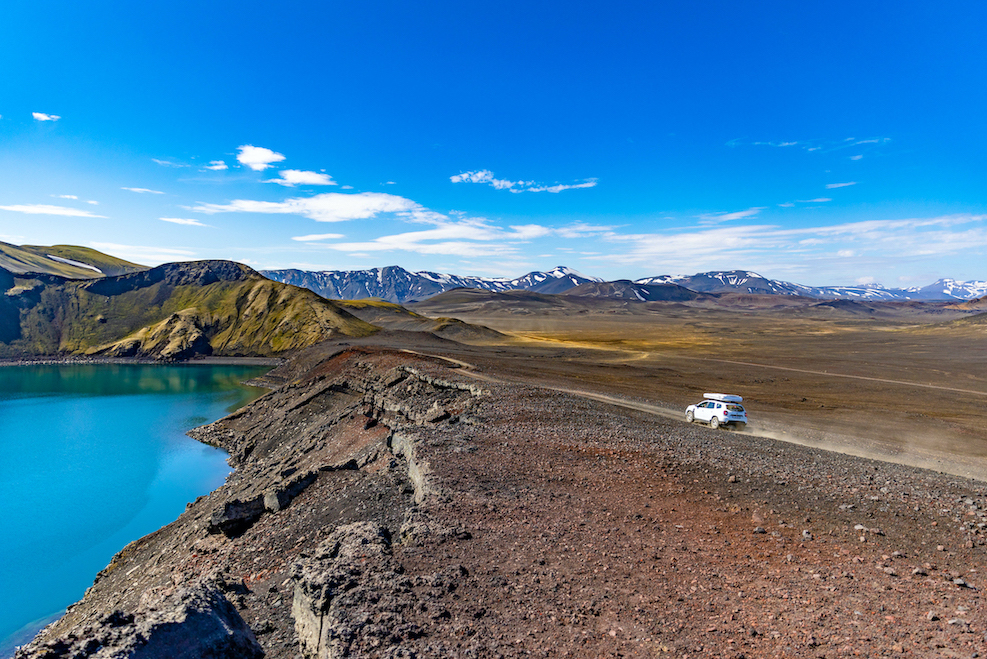
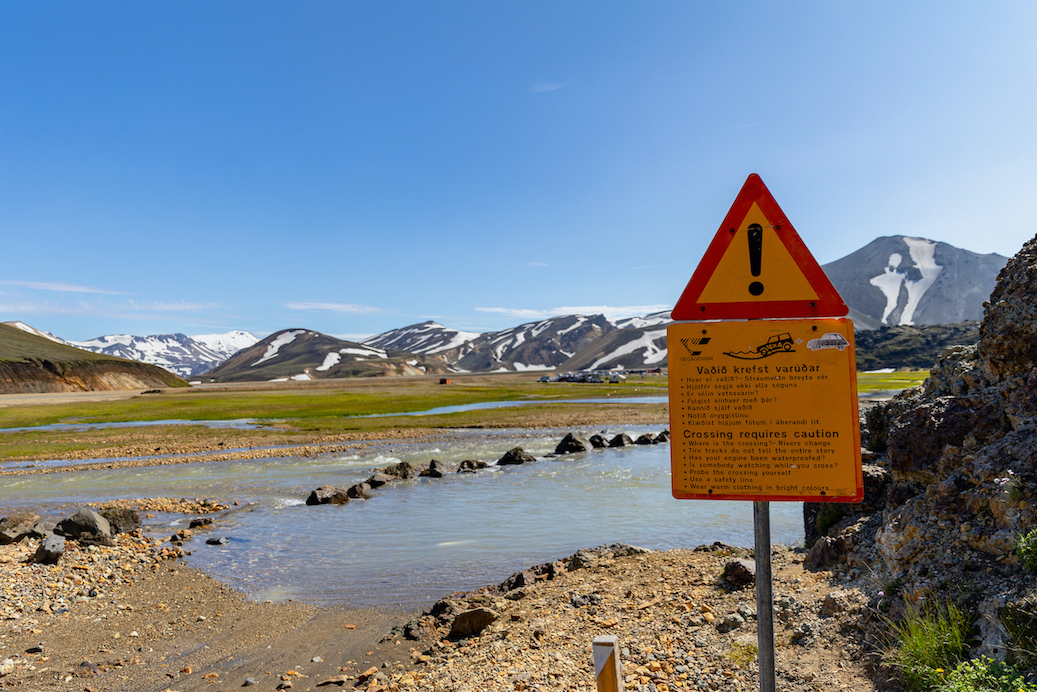

Am Visitor Center angekommen, empfehlen wir Euch die Wanderung durch das Lavafeld Laugahraun. Anschließend geht es vorbei an den bunten Rhyolitbergen, durch Gletscherschnee und weiter entlang rauchender Fumarole und am Fluss entlang durch einen grünen Canyon. Orientieren könnt ihr euch am besten mit der All Trails App, denn es gibt immer wieder Abzweigungen – etwa zum Vulkan Blahnjukur oder zum „brennenden“ Berg Brennisteinsalda. Zu Anfang der Wanderung solltet ihr den Wegweisern zu diesen beiden Bergen folgen, um dem Landmannalaugar Short Loop zu folgen. Wir sind den Blahnjukur nicht hochgestiegen und haben für die wundervolle Wanderung zwei Stunden und 20 Minuten gebraucht – mit vielen Fotostopps natürlich. Dabei haben wir 5,6 Kilometer Strecke zurückgelegt und 150 Höhenmeter bezwungen.
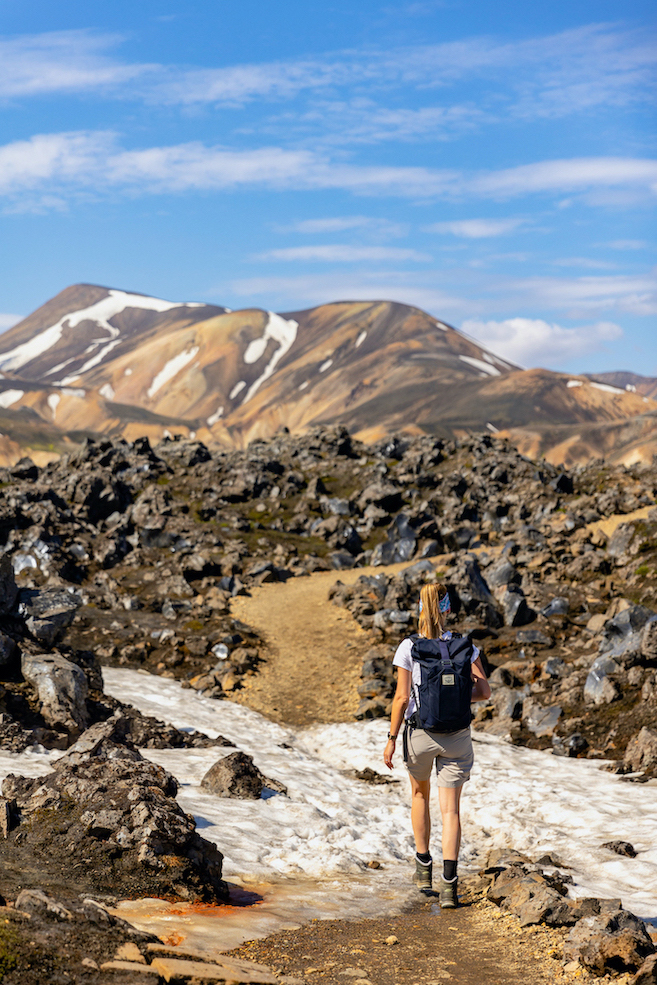
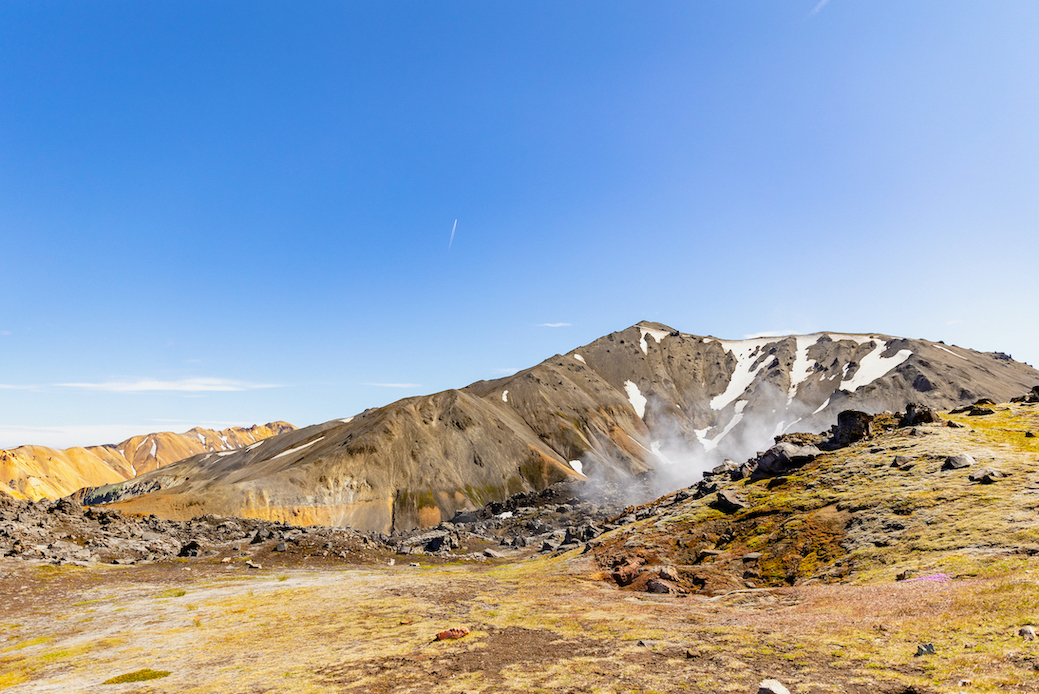
Nach der Rückkehr zum Visitor Center solltet ihr noch einen kleinen Abstecher zu den heißen Quellen von Landmannalaugar machen. Genau das Richtige nach einer anstrengenden Wanderung. Vom Visitor Center aus geht ihr einen kleinen Holzpfad entlang bis zur Badeplattform, wo ihr euch umziehen könnt (keine Umkleiden). Über eine kleine Treppe steigt ihr ins Wasser. Hier ist es noch relativ kalt, aber je weiter ihr flussabwärts im hüfttiefen Wasser schreitet, desto wärmer wird es. Dort wo der kleine Wasserfall in den Bach fließt, wird es richtig heiß. Ihr müsst also durch Wahl des richtigen Platzes die Temperatur steuern. Wenn der aber mal gefunden ist, kann man es hier getrost länger aushalten.
Landmannalaugar hat uns wirklich sehr gut gefallen und wir legen es euch wirklich ans Herz. Beim nächsten Island Trip möchten wir mit dem Camper gerne noch viel weiter ins Hochland vorstoßen.
Hotelvorschlag als Alternative zum Camper: Perfekte Ausgangslage für Gulfoss, Geysir, Landmannalaugar und Silfra Spalte*
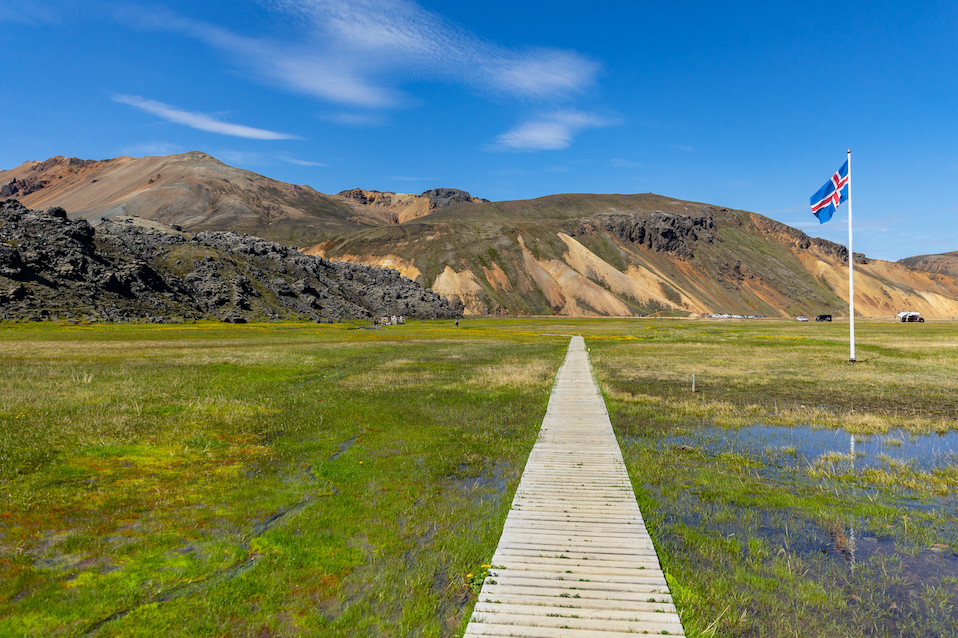
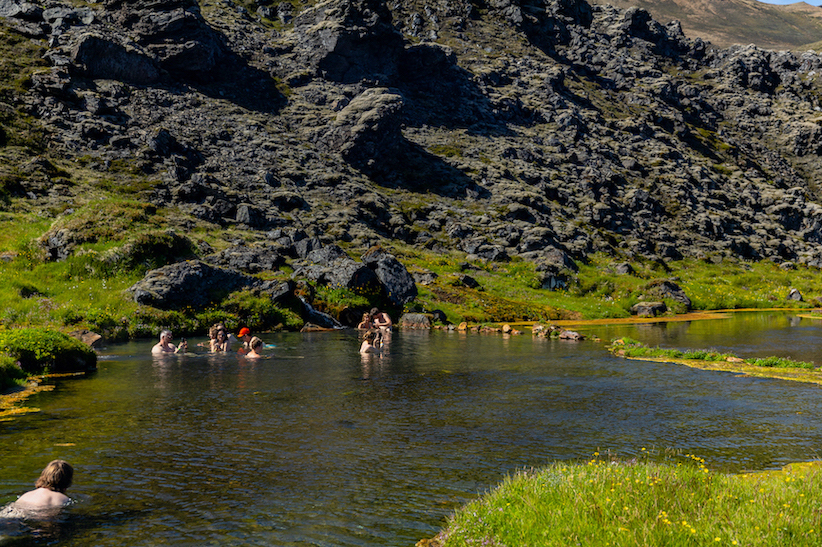
Strände in Island
Reynisfjara
Der Reynisfjara Strand ist einer der berühmten Black Sand Beaches in Island. Direkt hinter dem schmalen Sandstreifen thronen hohe Basaltwände. Ihr könnt auch in eine mächtige Kaverne reingehen.
Vom Strand aus habt ihr einen guten Blick auf die Felsformationen der Halbinsel Dyrhólaey und die berühmte Seenadel aus Game of Thrones. Reynisfjara gilt als einer der gefährlichsten Strände Islands wegen der heimtückischen Sneaker Waves, die schon einige Leben in den letzten Jahren genommen haben. Besucht den Strand am besten bei Ebbe. Insgesamt wird euch hier vermutlich eine Stunde ausreichen.
Hotelvorschlag als Alternative zum Camper: Perfekt für Seljalandsfoss, Skogafoss, Rejnisfjara und Fjaðrárgljúfur*
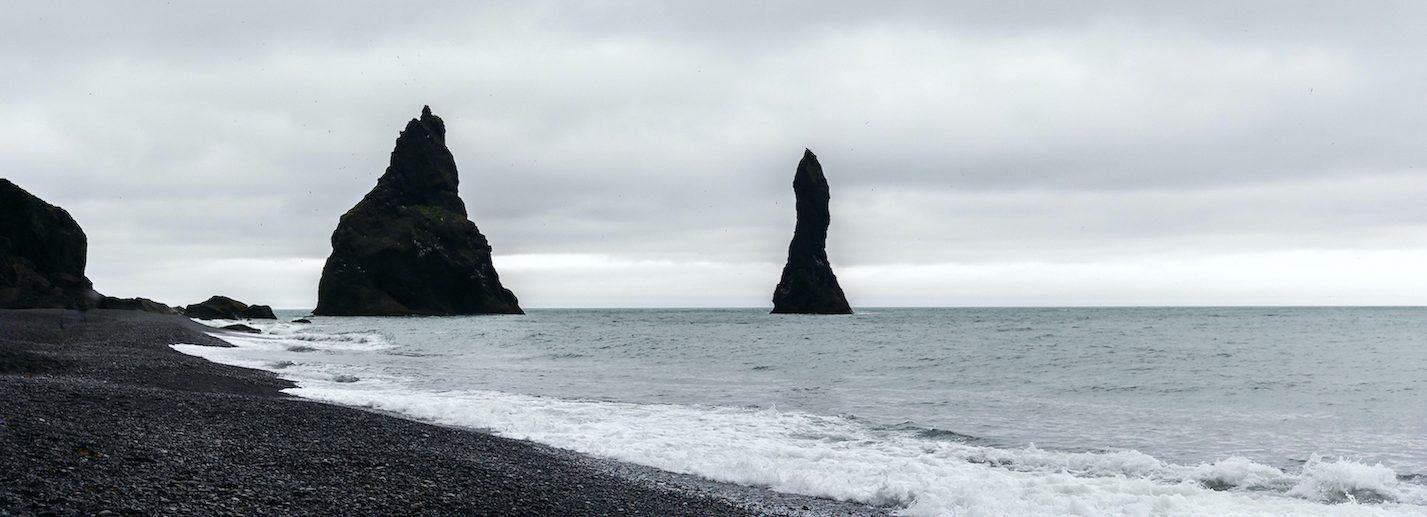
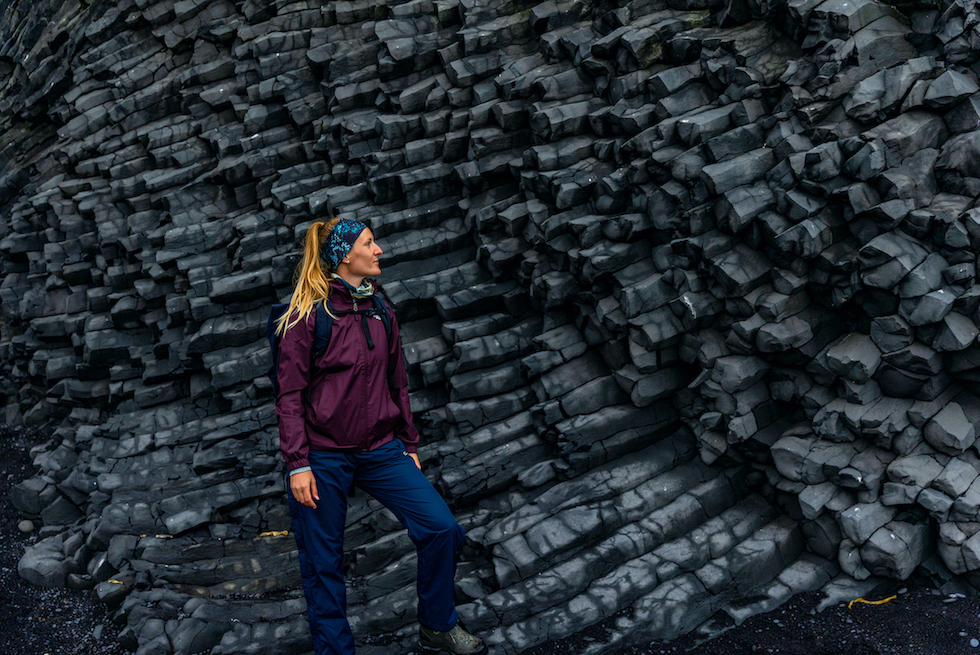
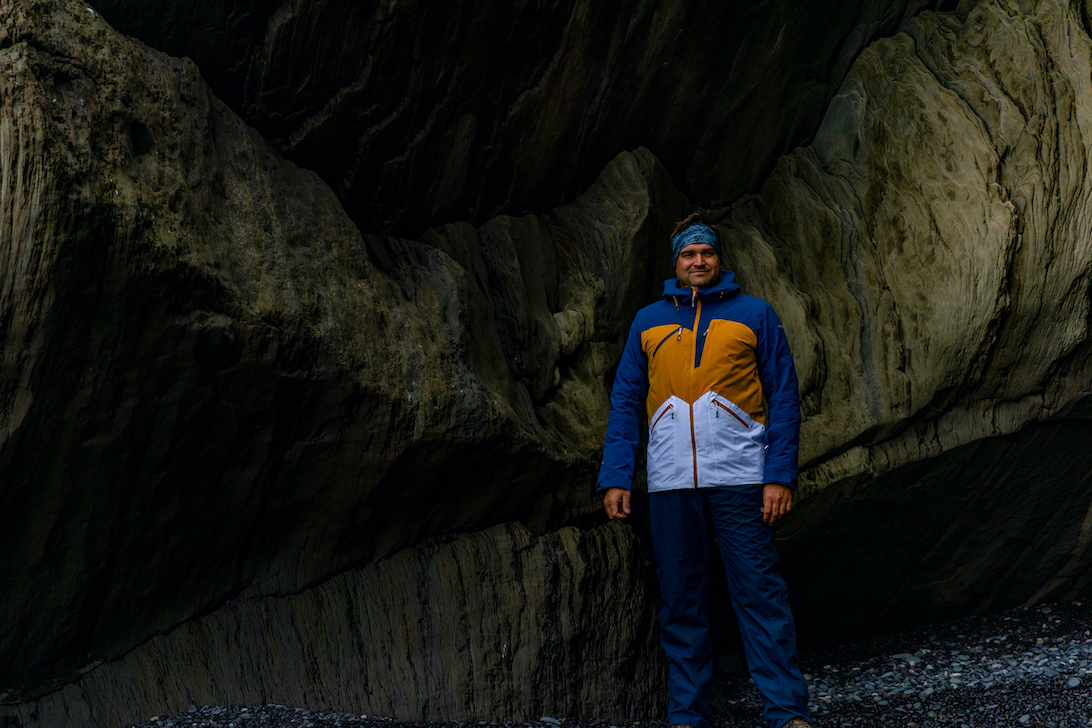
Diamond Beach
Der Diamand Beach ist wirklich spektakulär. Wir hatten etwas Angst, dass unsere Erwartungen etwas enttäuscht werden, weil wir schon so viele Instagram-Bilder gesehen haben. Die Realität ist aber noch schöner. Der Diamond Beach ist ein schwarzer Strand aus Lavasand, an den große Eisberge und kleinere Eisbrocken von der Brandung angespült werden. Die Eisberge kommen von einer Gletscherzunge des Vatnajökulls, die in den Jöküllsarlon Gletschersee kalbt und von dort in den nahen Atlantik gespült werden. Die funkelnden Eisbrocken auf dem schwarzen Sand sehen wirklich fantastisch aus. Ihr könnt direkt hinter dem Strand kostenlos parken. Kommt am besten bei Ebbe. Wenn das Wetter etwas diesig ist, ist die Stimmung wirklich mystisch. Absolute Empfehlung.
Hotelvorschlag als Alternative zum Camper: Unbekannt und top bewertetes Guesthouse als Base für Diamond Beach und Gletscherseen*
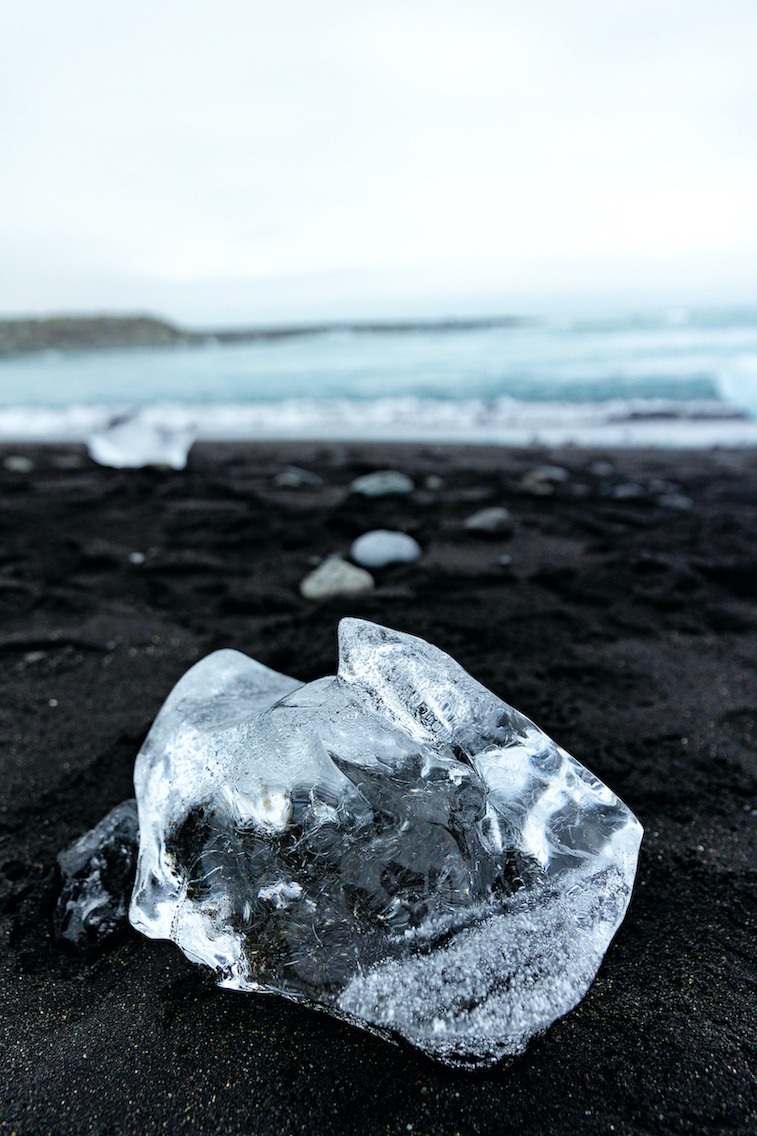
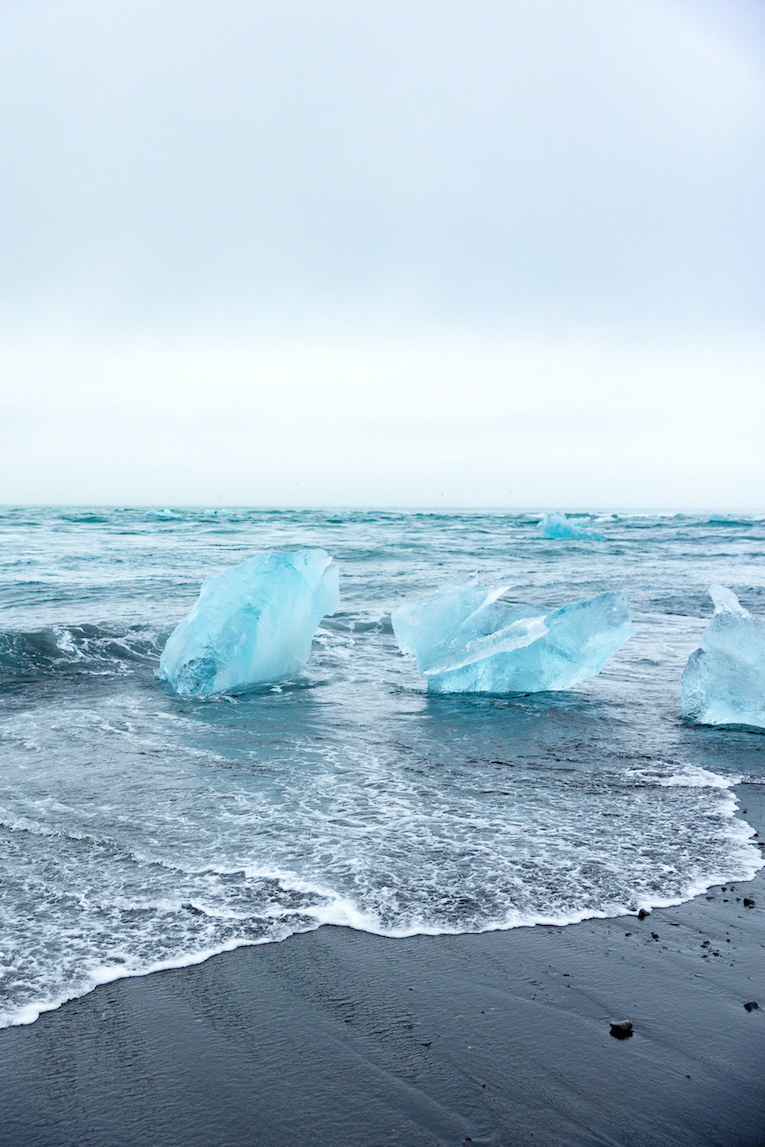
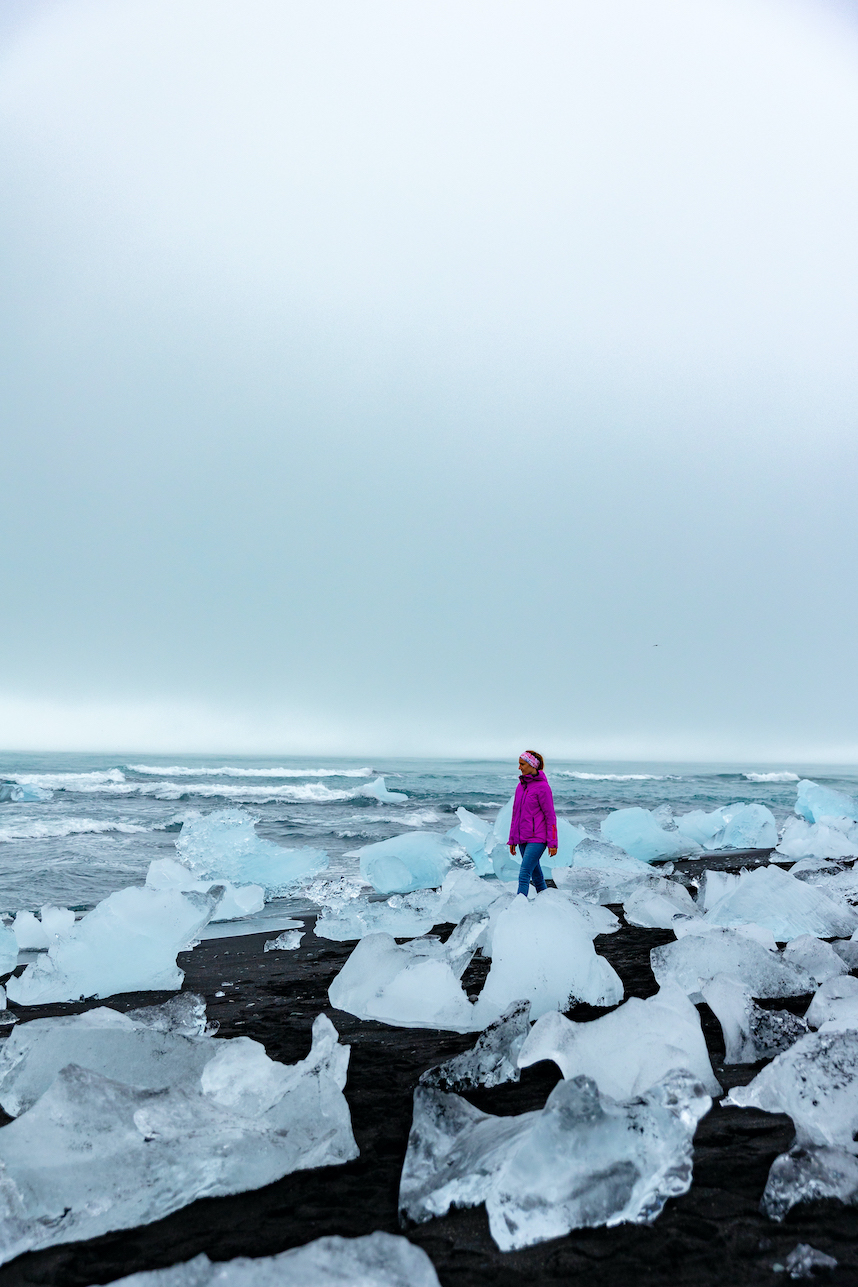
Kerid Krater
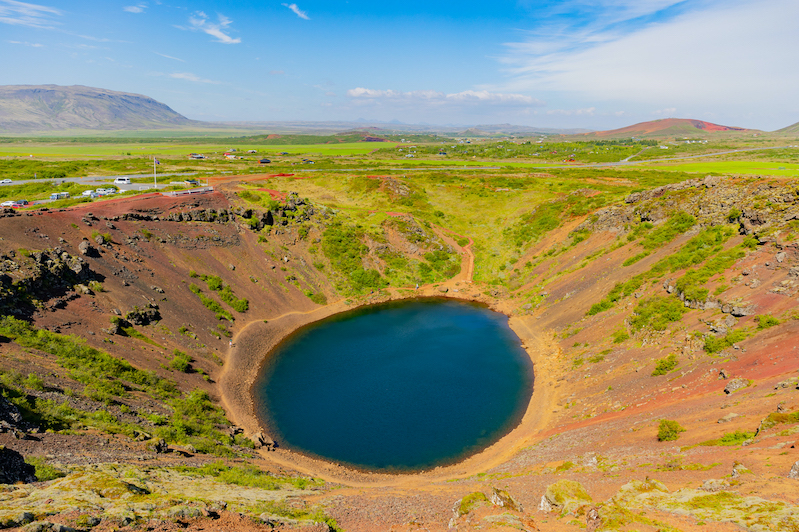

Geysir
Das Wort Geysir beschreibt eigentlich eine heiße Quelle, die in regel- oder unregelmäßigen Abständen eine Fontäne ausstößt. Namensgebend für alle Geysire dieser Welt ist „der“ Geysir in Island. Er brach früher regelmäßig aus. Heute nur noch in Folge starker Erdbeben. Dann aber richtig hoch. In der Umgebung des ursprünglichen Geysir liegt der Geysir Strokkur, der alle drei bis sieben Minuten ein 15 bis 25 Meter hohe Fontäne ausbläst. Damit ist er zusammen mit den Geysiren in Yellowstone, USA einer der höchsten Geysire der Welt.
Wir fanden den Strokkur schon sehr spektakulär. Die Wege sind gut befestigt. Besonderes Schuhwerk ist also nicht notwendig. Eintritt müsst ihr hier nicht bezahlen. Ein großes Visitor Venter mit Restaurants, Cafe und Souvenirshop ist auch vorhanden. Hier könnt ihr auch im Hotel oder auf dem nahen Campingplatz übernachten. Plant etwa eine Stunde Zeit ein.
Hotelvorschlag als Alternative zum Camper: Perfekte Ausgangslage für Gulfoss, Geysir, Landmannalaugar und Silfra Spalte*

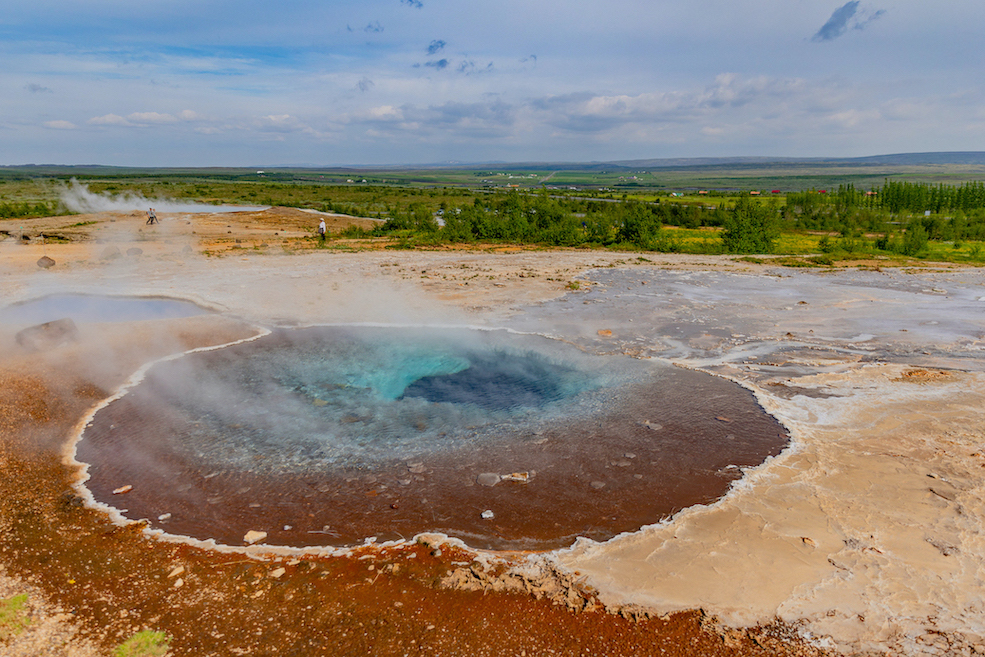
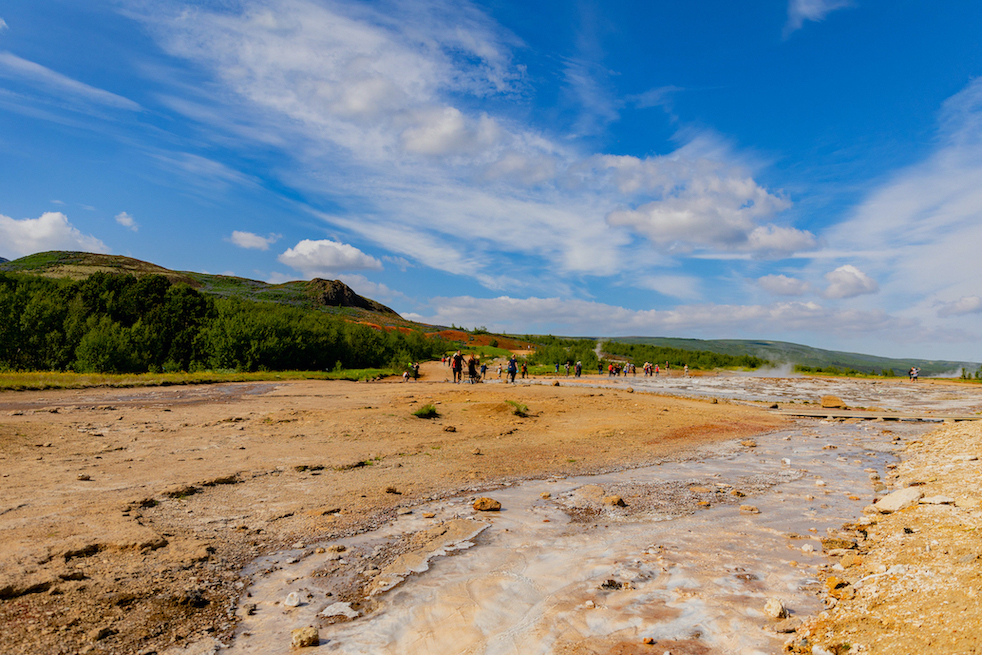
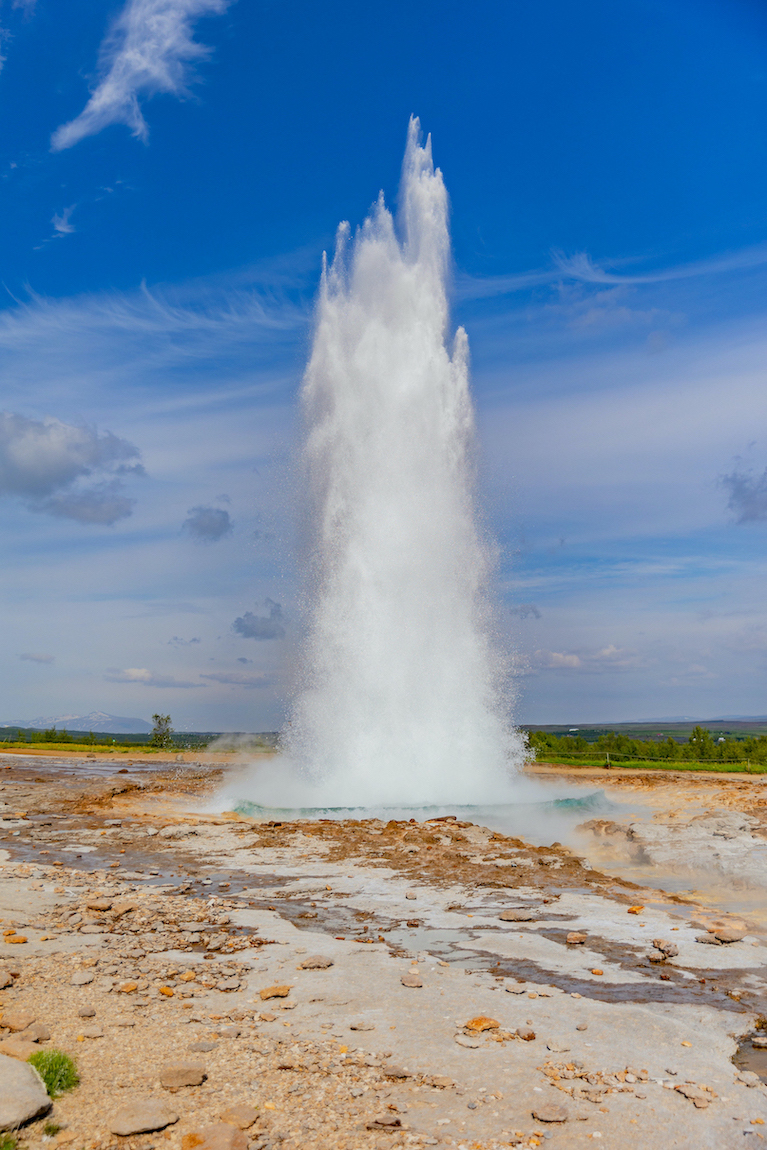
Fjadrargljufur Canyon
Dieser Canyon war wirklich mit das schönste, was wir jemals gesehen haben und für uns ein absolutes Highlight auf Island. Wir fragen uns, warum der eigentlich so unbekannt ist. Das satte Grün und die moosige Oberfläche sind einfach bezaubernd. Es gibt zwei kostenlose Parkplätze – nehmt aber besser den unteren direkt am Ausgang des Canyons. Dann könnt ihr den Fjadrargljifur Canyon entlang wandern bis zum letzten Aussichtspunkt und von dort den wundervollen Wasserfall Mögáfoss zu bestaunen. Der Canyon ist Teil des Geoparks Katla und wird von einem Ranger betreut.
Ein Schild am Eingang beschreibt die aktuellen Drohnenregelungen. Drohnen sind erlaubt, wenn Mensch und Tier nicht beeinträchtigt werden.
Insgesamt solltet ihr hier mit etwa einer Stunde gut auskommen. Ihr legt 70 Höhenmeter und 2,25 Kilometer zurück.
Hotelvorschlag als Alternative zum Camper: Perfekt für Seljalandsfoss, Skogafoss, Rejnisfjara und Fjaðrárgljúfur*
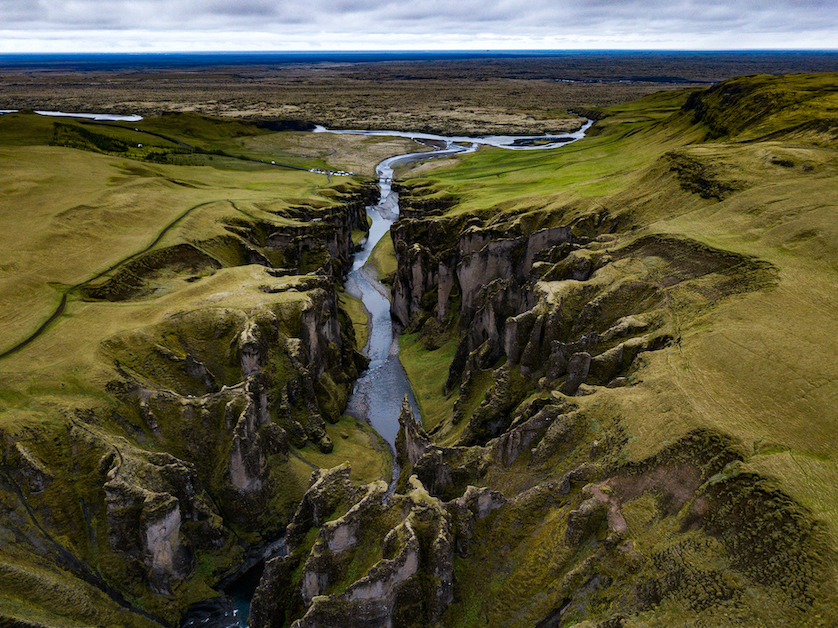
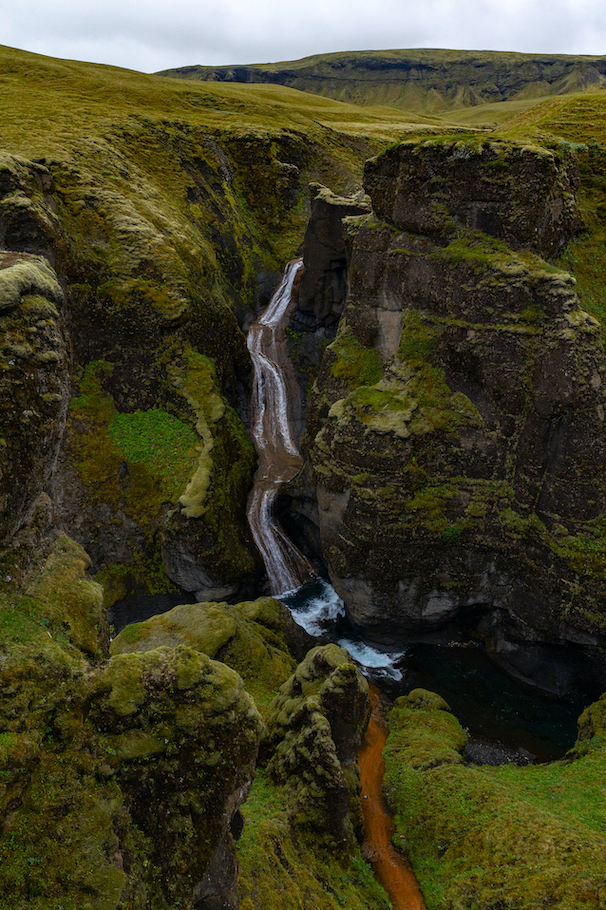
Gletscherseen Fjallsarlon und Joküllsarlon
Die beiden Gletscherseen Fjallsarlon und Joküllsarlon sind nur zehn Minuten auseinander und werden beide vom Gletscher Vatnajökull gespeist. Die Parkplätze sind direkt an der Hauptstraße und die Seen gleich dahinter. Der Joküllsarlon ist deutlich größer. Es schwimmen viele Eisberge in den beiden Seen. Wir haben auch eine Kegelrobbe zwischen den Eisbergen beim Jagen beobachtet. Macht auf jeden Fall einen Stopp hier. Aus dem Joküllsarlon fließt ein Fluss ins Meer und transportiert Unmengen an Eisbergen ins Meer. Die Brandung treibt die Eisberge wieder an den Strand. Dadurch entsteht der Diamond Beach.
Hotelvorschlag als Alternative zum Camper: Unbekannt und top bewertetes Guesthouse als Base für Diamond Beach und Gletscherseen*
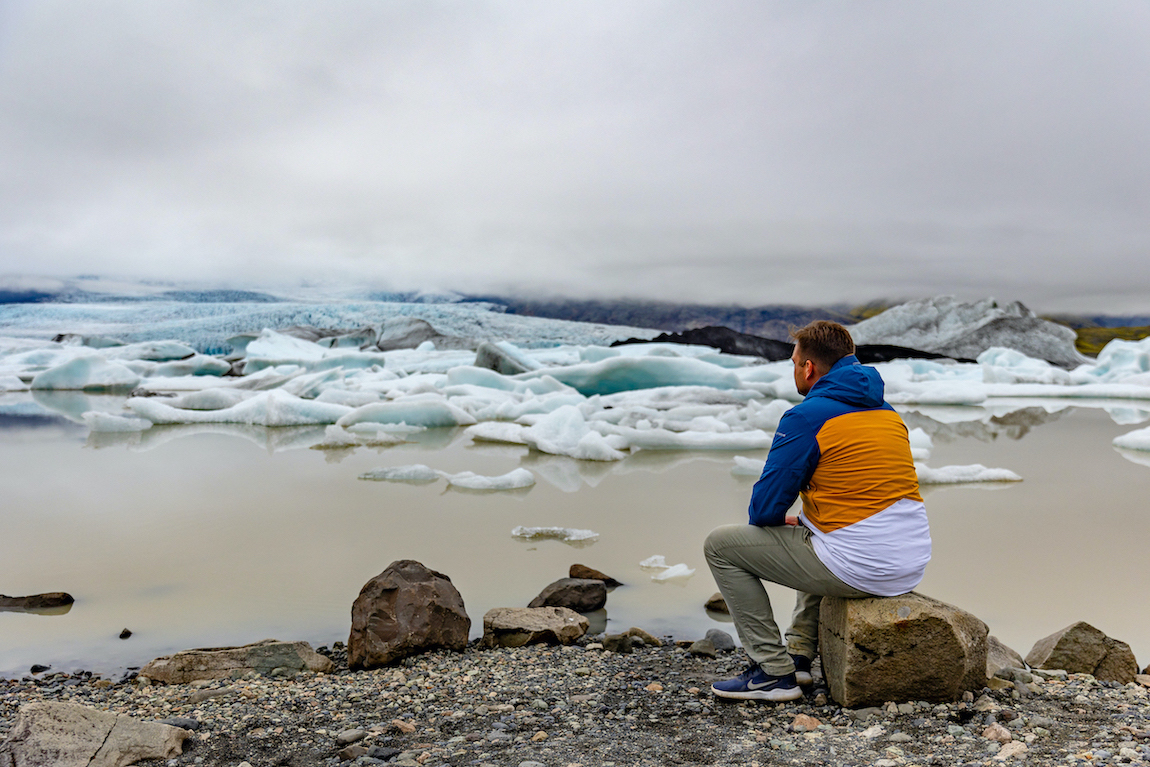
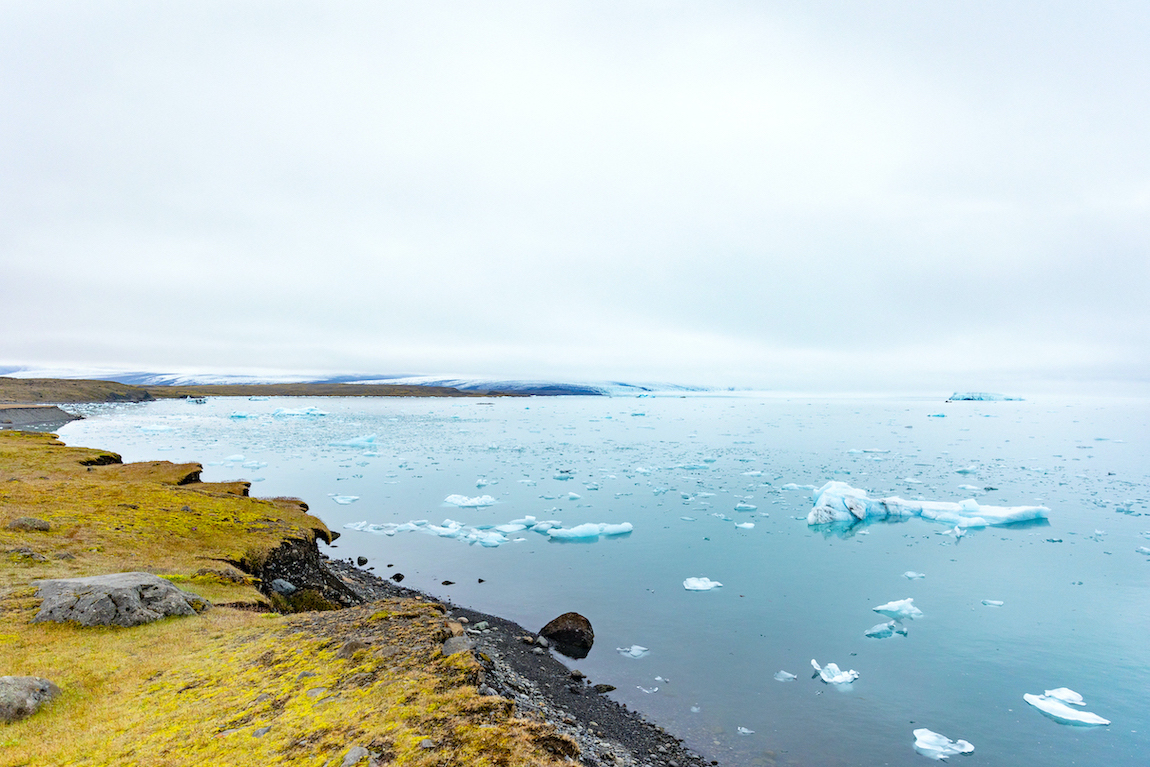
Studlagil
Den Studlagil Canyon habt ihr bestimmt schon mal auf Bildern gesehen. Dabei handelt es sich um einen kleinen Gebirgsfluss, der sich im Laufe der Zeit einen Weg durch das vulkanische Basaltgestein geschnitten hat.
Hier gibt es zwei – eigentlich sogar drei – Optionen zum Parken. Wenn ihr von der asphaltierten Straße kommt, geht es nach einigen Kilometern mal links weg Richtung Fluss. Dort findet ihr bei zwei Brücken einen Parkplatz. Ihr könnt hier kostenlos parken und einen längeren Marsch zum Canyon in Kauf nehmen oder ihr fahrt mit eurem Auto über die Brücke und folgt dem Weg auf der anderen Seite etwa zwei Kilometer bis zu einem weiteren Parkplatz. Der Weg dorthin ist einspurig und etwas Bodenfreiheit beim Auto schadet auch nicht. Mit unserem Dacia Duster hatten wir hier keine Probleme. Von diesem Parkplatz aus habt ihr noch etwa 30 Minuten Fußweg vor euch bis ihr im Canyon steht. Wir würden euch diese Option empfehlen.
Bei der anderen Option fahrt von der asphaltierten Straße aus kommend an der Abzweigung zu den Brücken einfach vorbei bis ihr zum Studlagil Parkplatz kommt. Der ist auch ausgeschildert. Von hier könnt ihr von einer Aussichtsplattform von oben in den Canyon schauen. Die Möglichkeit in den Canyon abzusteigen besteht hier nicht.
Der Studlagil gehört für uns zur ersten Kategorie der Island Highlights die ihr auf eurer Rundreise nicht verpassen solltet. Die grauen perfekt geformten Basaltsäulen in Kombination mit dem eisblauen Gletscherwasser sucht seines Gleichen. Wir haben für die Option mit dem Überqueren der Brücke mit dem Auto etwa zwei Stunden inklusive ausgiebigen Fotografieren am Studlagil Canyon gebraucht. Dabei haben wir 5,8 Kilometer zu Fuß zurückgelegt und 94 Höhenmeter überwunden.
Hotelvorschlag als Alternative zum Camper: Schnell sein und früh buchen – oft ausgebucht*
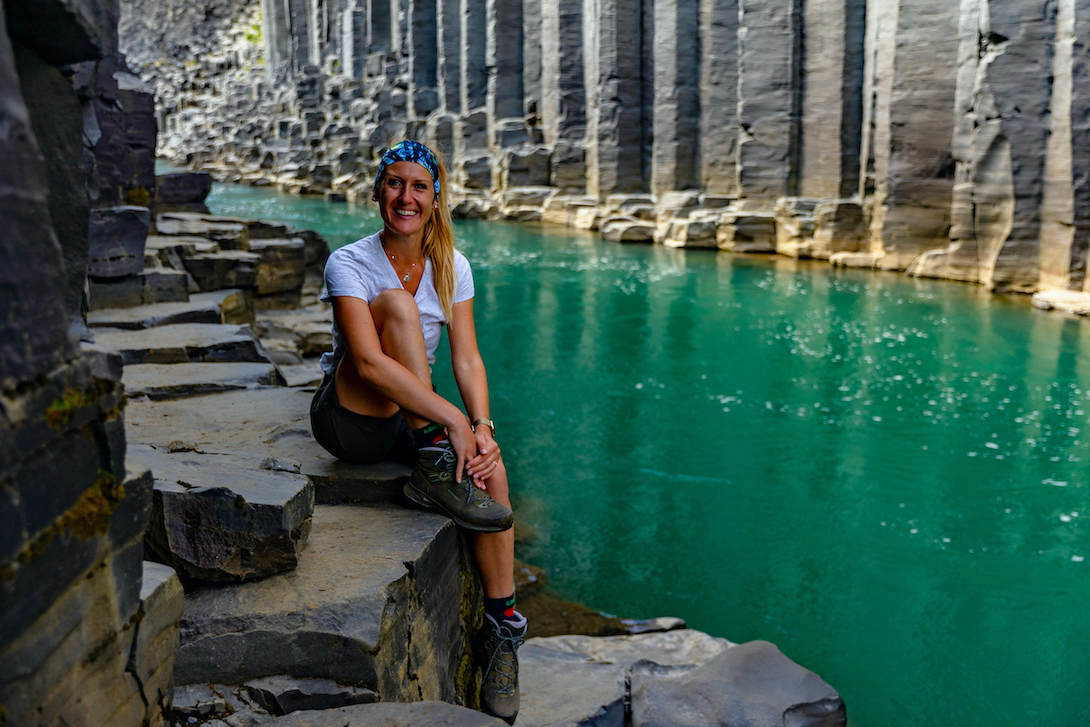

Silfra Spalte – Schnorcheln und Tauchen auf Island
Die Silfra Spalte liegt im Isländischen Pingvellir Nationalpark, der Ort, wo das erste Isländische Parlament tagte. Dabei handelt es sich um eine Verwerfung, die durch das Auseinanderdriften der Eurasischen und Amerikanischen tektonischen Platte entstanden ist. Die Silfra Spalte oder auch Silfra Fissure ist Teil des Mittelatlantischen Rückens. Schnorcheln oder Tauchen ist hier nur mit einem kommerziellen Anbieter möglich. Wir haben uns für den Anbieter Adventure Vikings* entschieden und haben uns sehr gut aufgehoben gefühlt. Parkt am besten am Parkplatz P5 im Nationalpark. Das kostet 750 ISK und wird an einem Bezahl-Terminal mit Kreditkarte bezahlt. Dazu braucht ihr euer Autokennzeichen. Seid am besten 15 Minuten vorm vereinbarten Treffpunkt vor Ort.
Wenn alle Teilnehmer da sind, geht’s mit einem ausführlichen Briefing und der Anprobe der Ausrüstung los. Die beiden sehr freundlichen und kompetenten Guides Maria und Luis beraten euch gerne bei der Auswahl des richtigen Tauchanzugs. Ihr könnt zwischen einem Wetsuite und Drysuite wählen. Der Drysuite ist natürlich wärmer, weil kein Wasser an die Haut kommt außer im Gesicht. Jedoch seid ihr in der Bewegungsfreiheit sehr stark eingeschränkt, denn ihr könnt damit nicht abtauchen. Ich würde einen Wetsuite empfehlen. Die ersten zwei Minuten sind schon etwas frostig, aber sobald sich der Wasserfilm zwischen Neopren und Haut aufgewärmt hat, ist es echt ok. Neben Anzug mit Kopfhaube bekommt ihr auch noch Stiefel und Handschuhe aus Neopren sowie Flossen, Schnorchel und Tauchermaske. Wenn ihr euch für einen Tauchgang statt Schnorcheln entschieden habt, bekommt ihr natürlich noch mehr Equipment. Wobei ich nicht wüsste, warum man in der Silfra Spalte tauchen sollte. Ich denke schnorcheln ist hier ausnahmsweise mal die bessere Wahl. Pro Guide sind maximal sechs Teilnehmer zugeordnet.
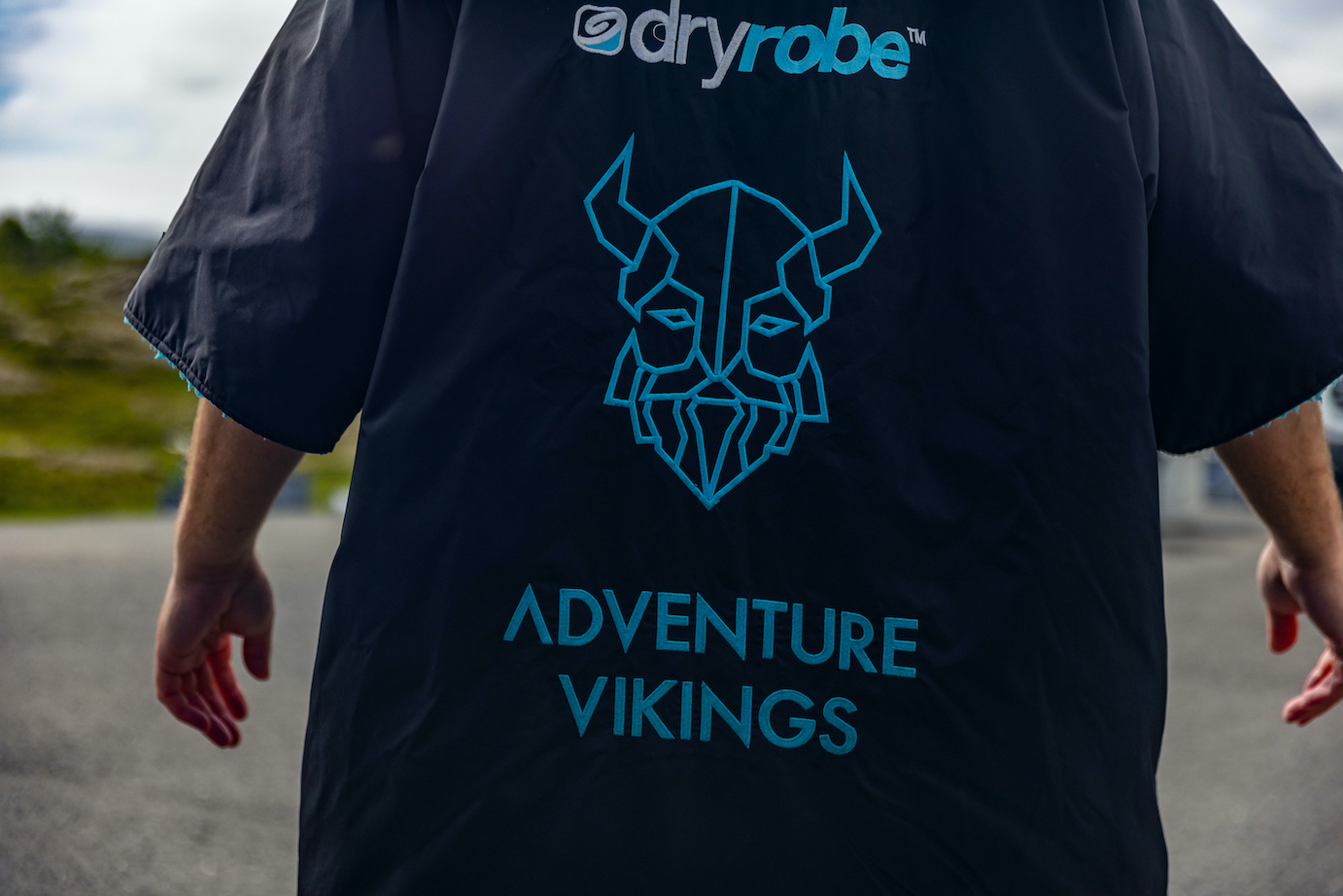
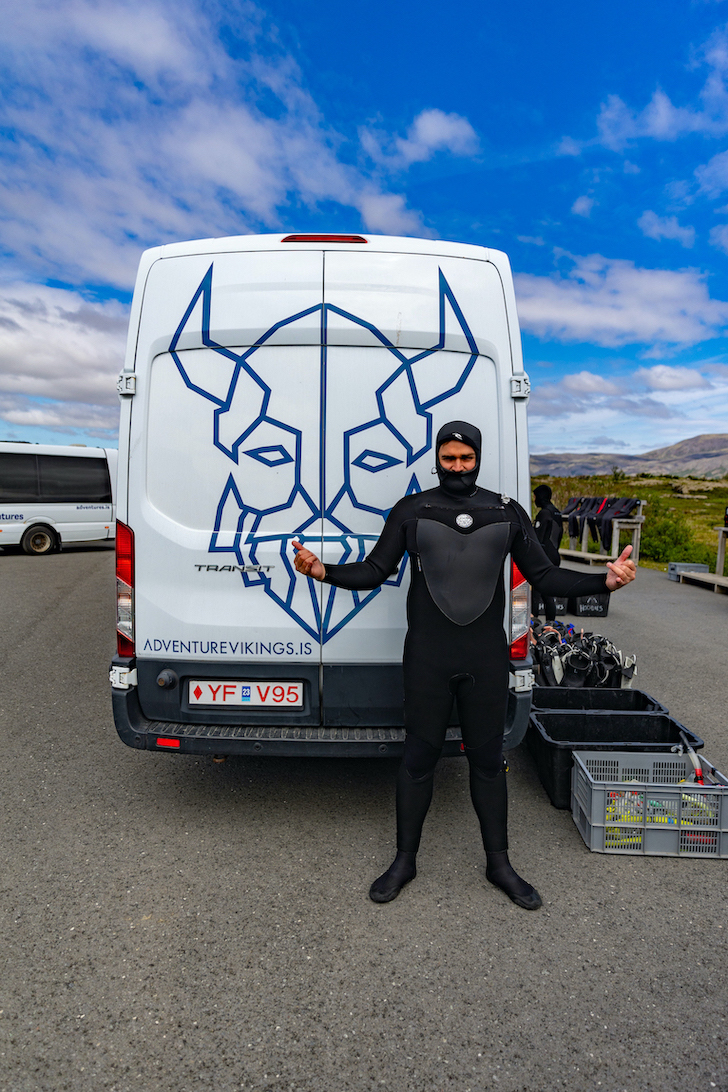
Nun geht es mit angezogener Ausrüstung bis zur Einstiegsstelle. Das sind etwa zwei Minuten Fussweg. Nacheinander geht es ins Wasser und es wird im Kreis geschwommen was das Zeug hält, damit es einem warm wird. Immer dem Guide hinterher, schwimmt ihr im klarsten Wasser des Planeten zwischen zwei Felswänden hindurch. Die Sichtweite beträgt je nach Wetter und Sonneneinstrahlung unglaubliche 150 bis 250 Meter.
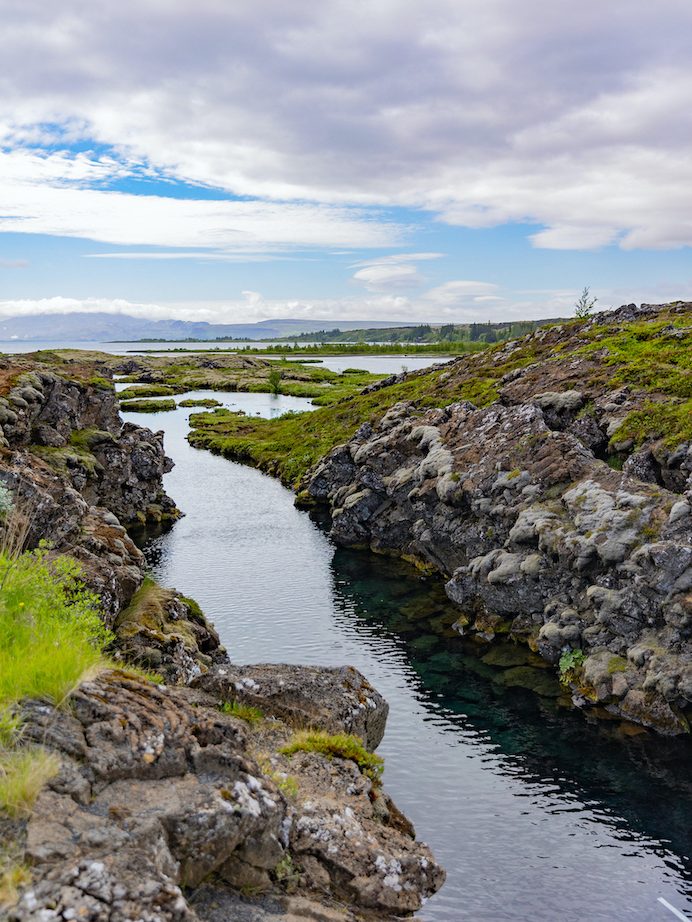
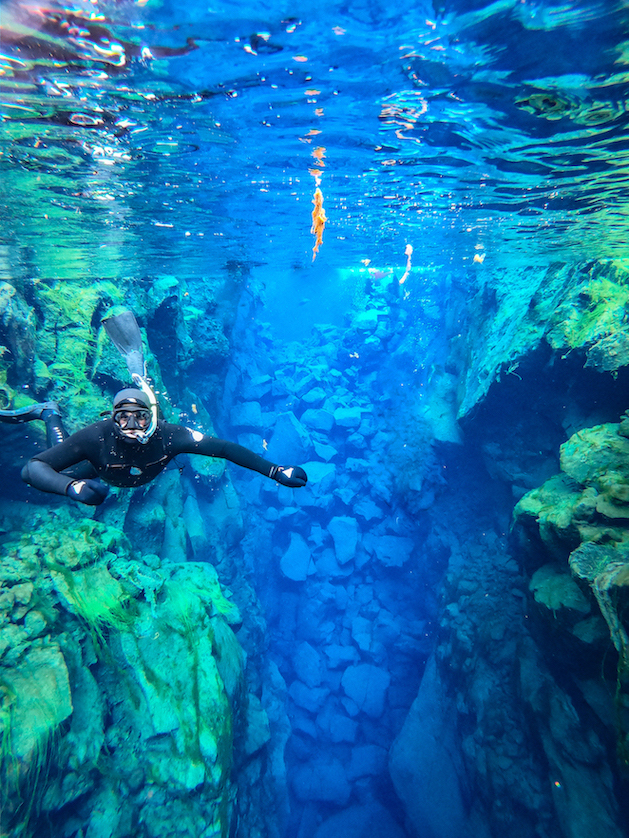
Spektakuläre Felsformationen, neongrüne Algen und Sonnenstrahlen, die das Wasser durchschneiden kommen des Weges. Der Guide gibt immer wieder Anweisungen für Posen, damit spektakuläre Bilder mit der GoPro entstehen. Die Bilder könnt ihr euch dann kostenlos ein bis zwei Tage später herunterladen. Highlight des etwa 20-minütigen Schnorchelgangs ist die sogenannte Kathedrale und die Lagune ganz am Ende vor dem Ausstieg. Nachdem alle wieder an Land sind, geht’s im Gänsemarsch zurück zum Parkplatz und den Vans von Adventure Vikings, wo schon heiße Schokolade und helfende Hände zum Ausziehen auf euch warten. Insgesamt war das Schnorcheln / Tauchen in der Silfra Spalte eine unserer spektakulärsten Aktivitäten auf Island. Plant dafür etwa zwei Stunden ein.
Hotelvorschlag als Alternative zum Camper: Perfekte Ausgangslage für Gulfoss, Geysir, Landmannalaugar und Silfra Spalte*
